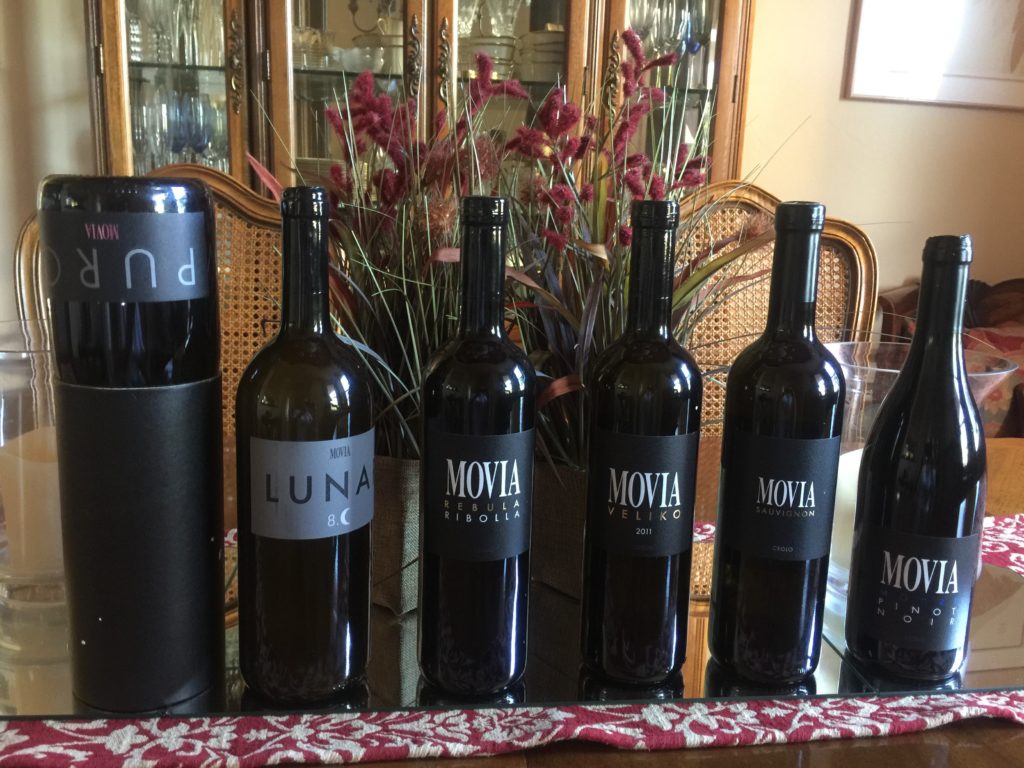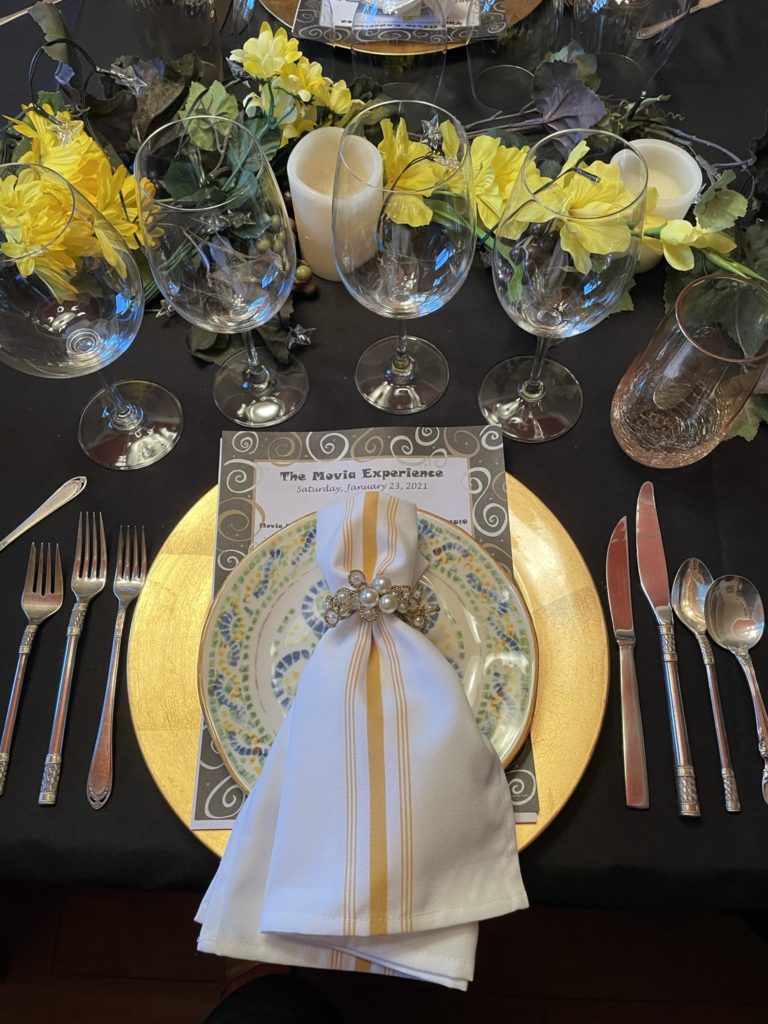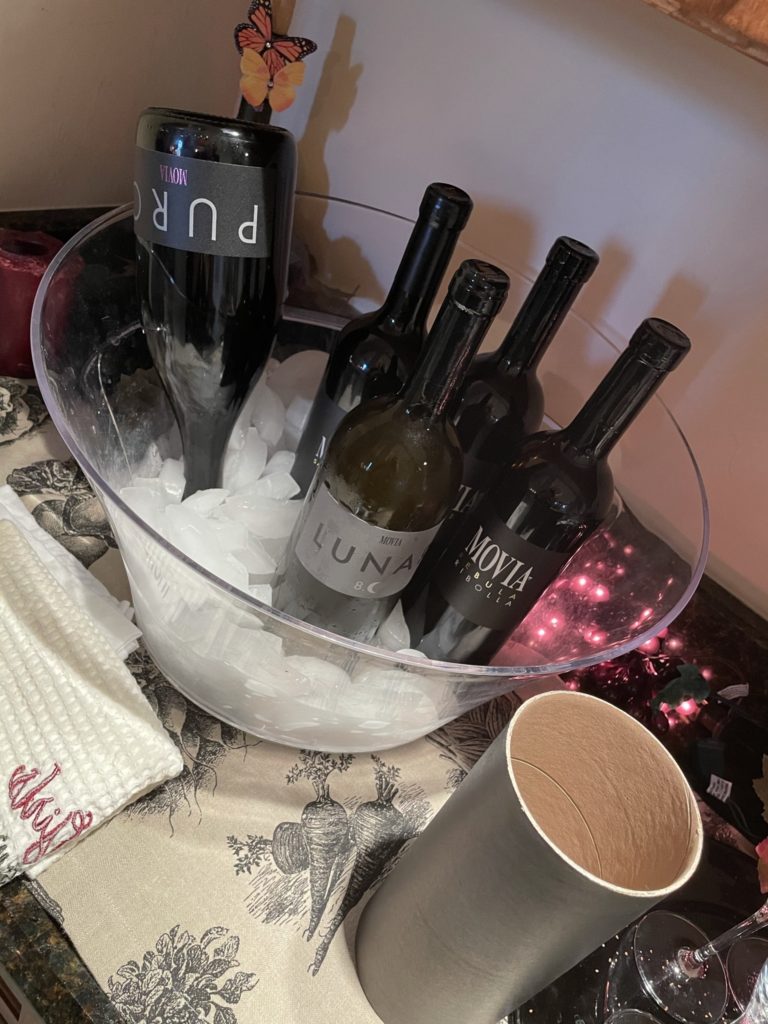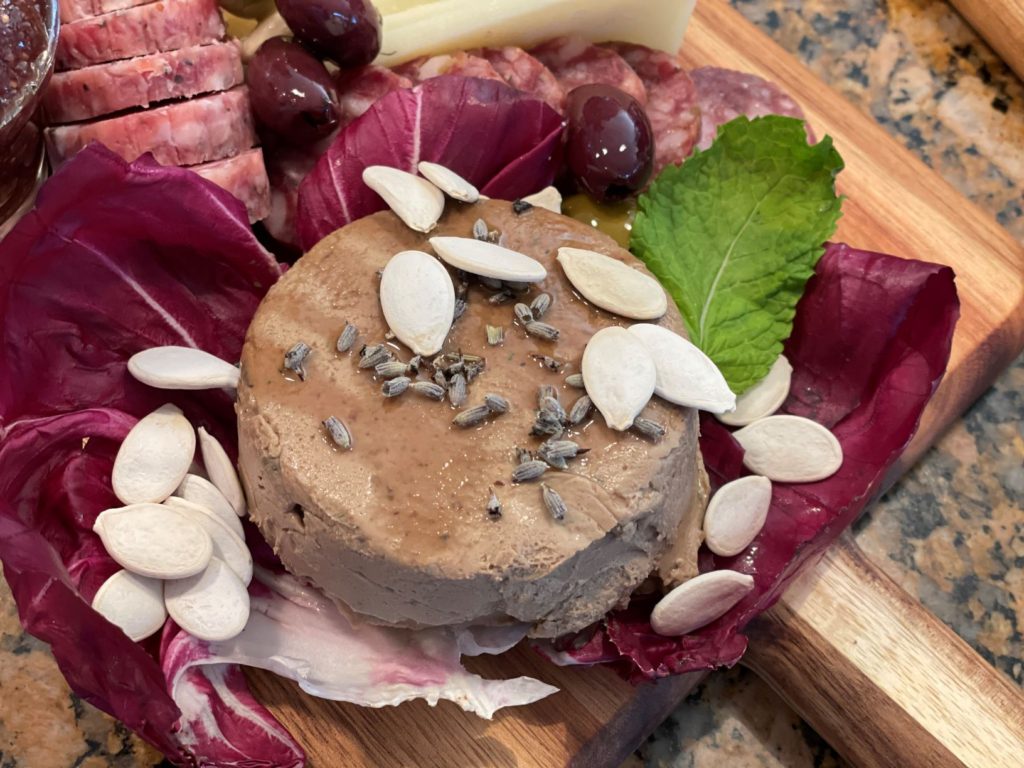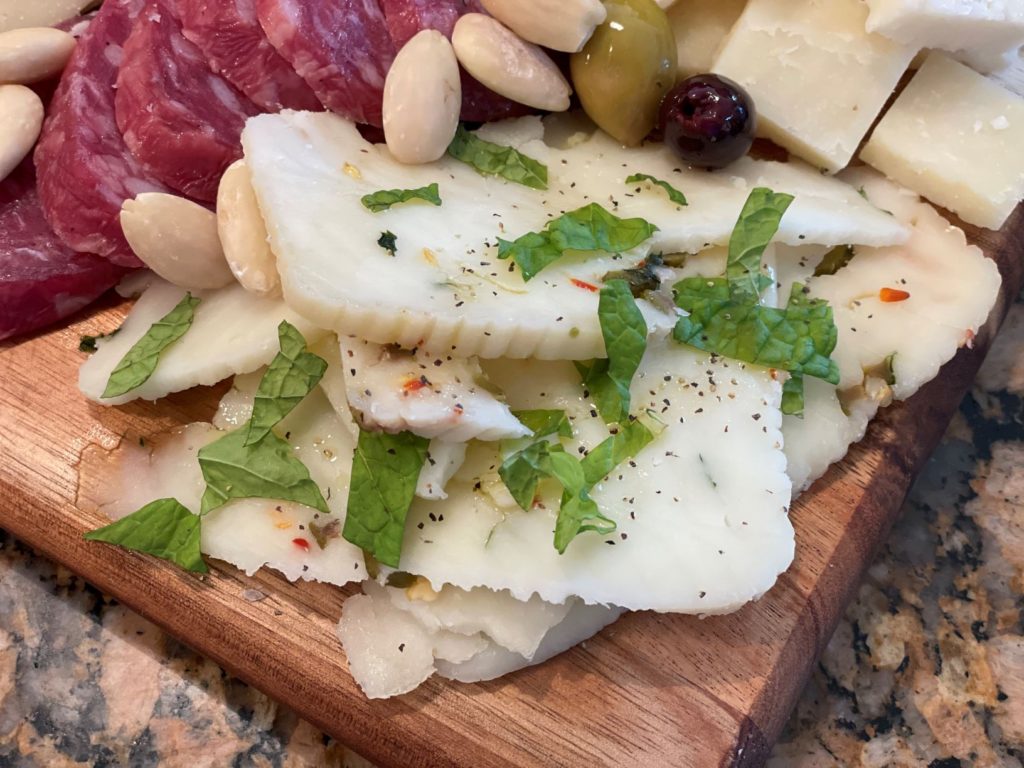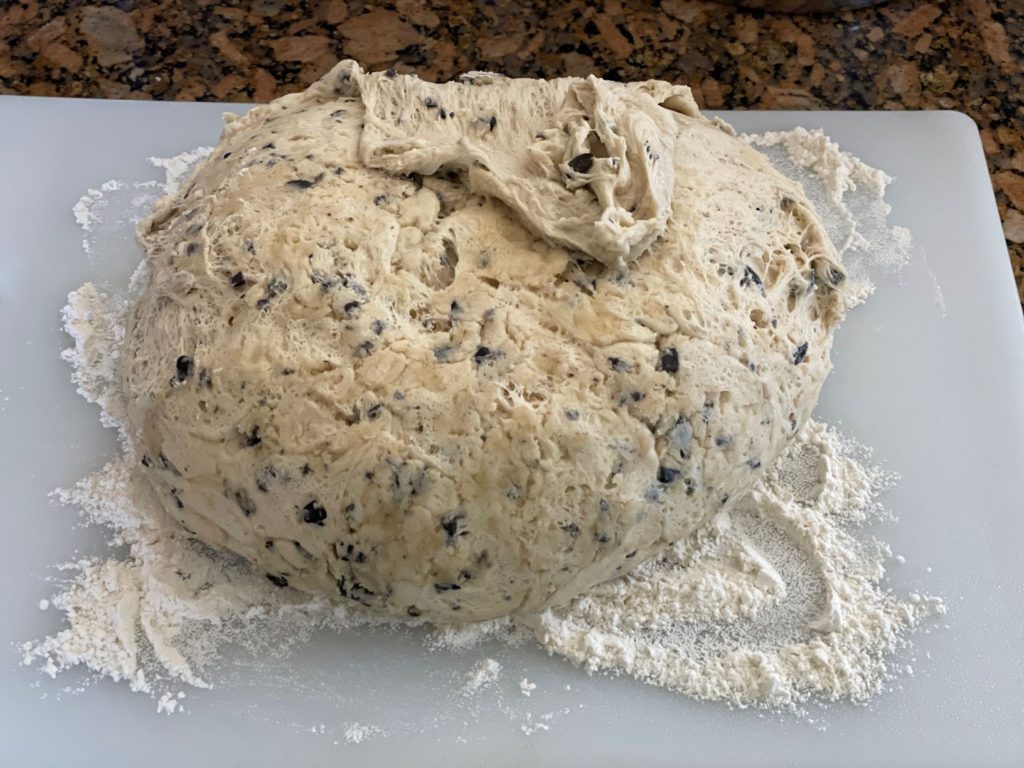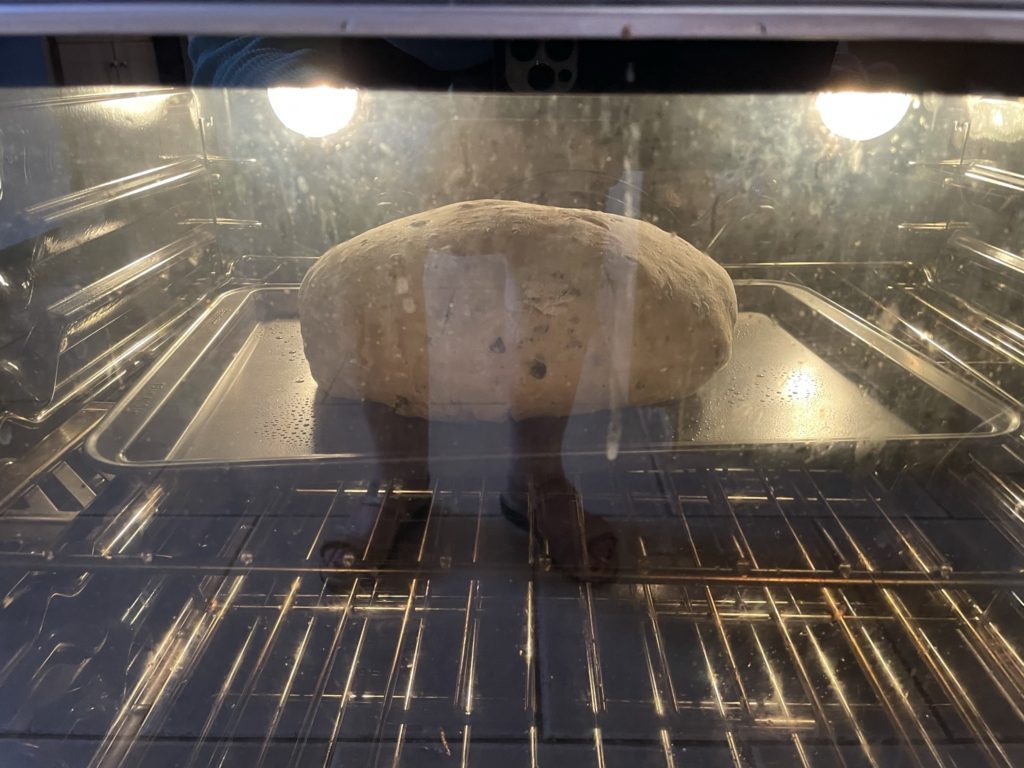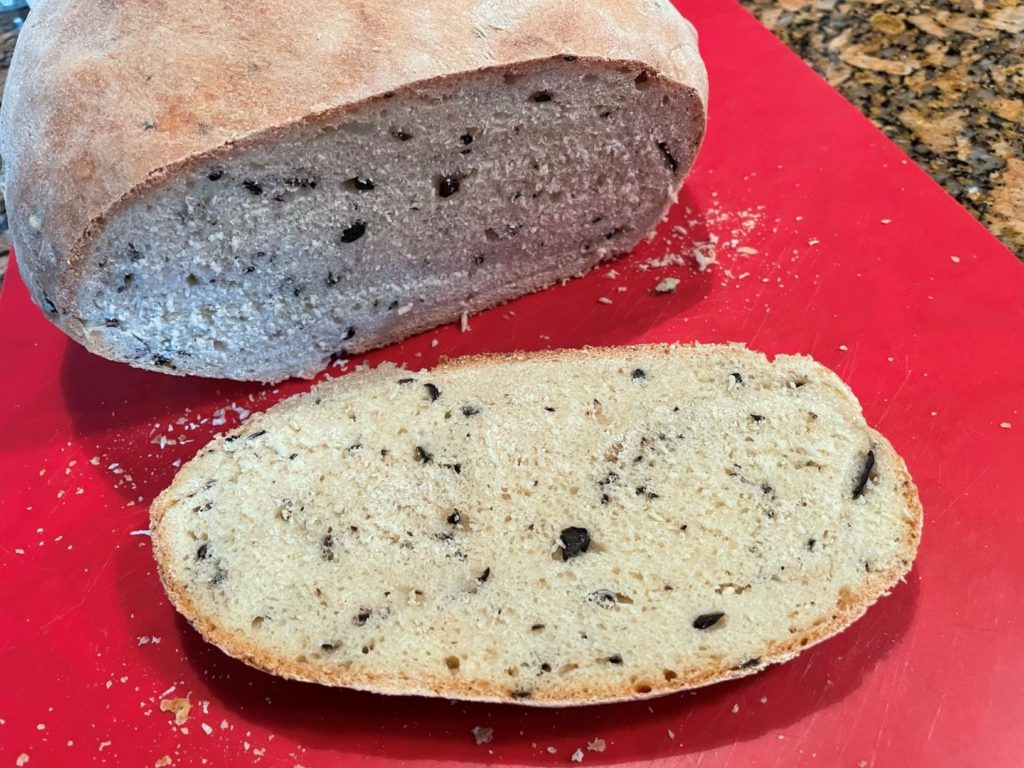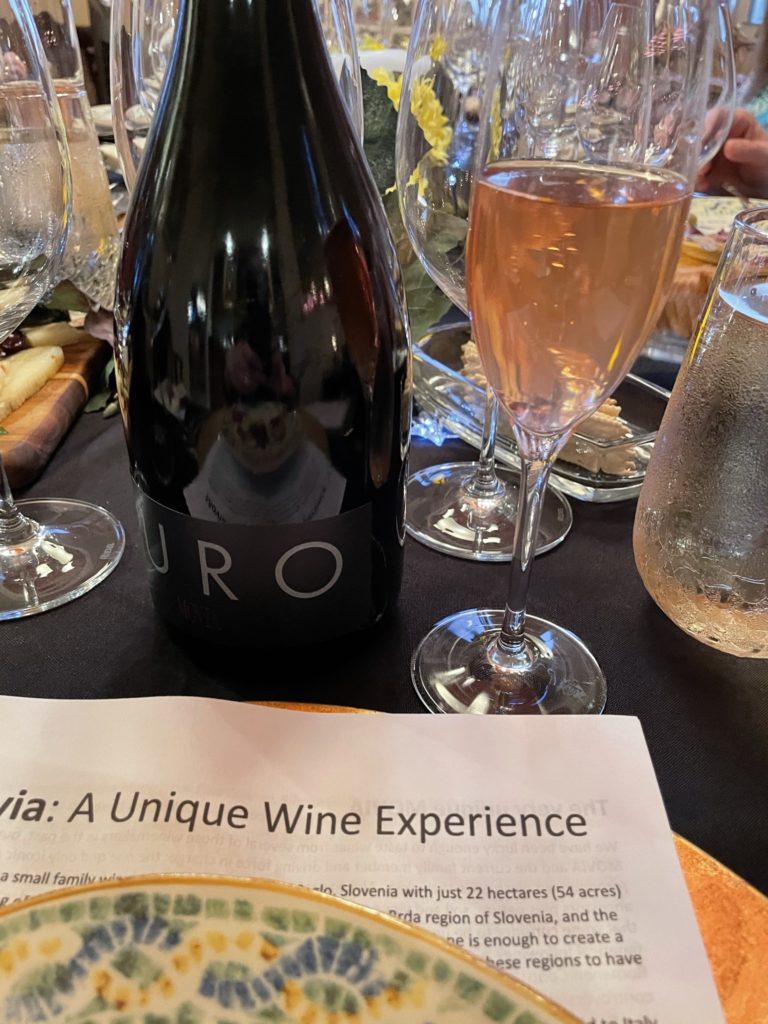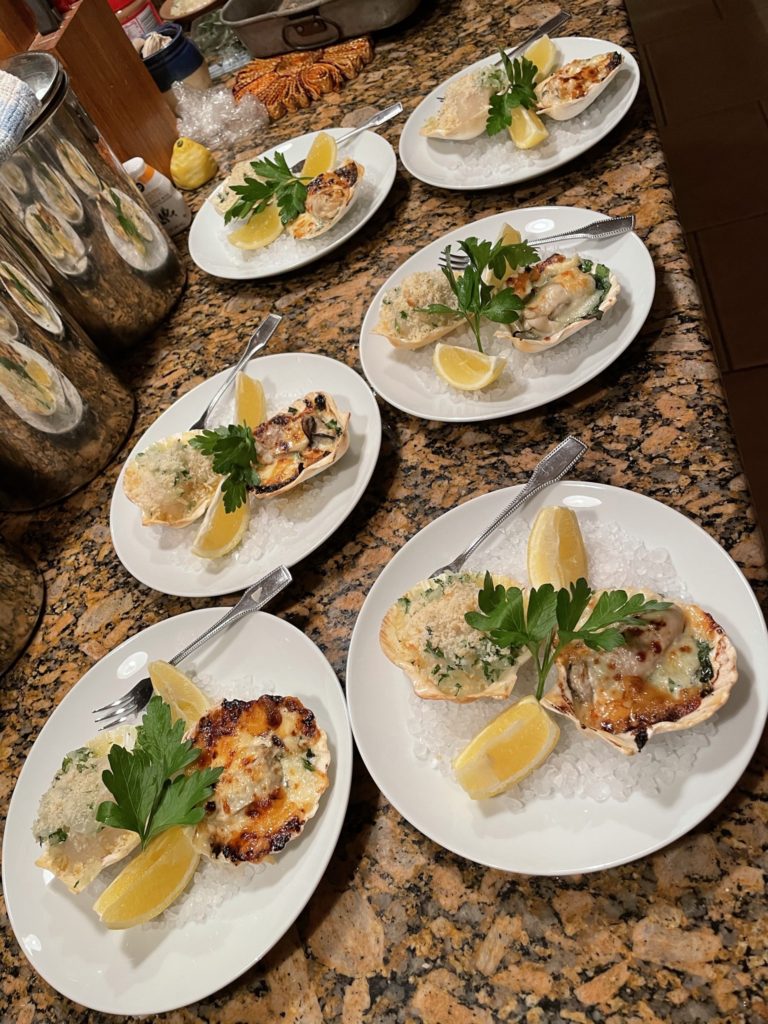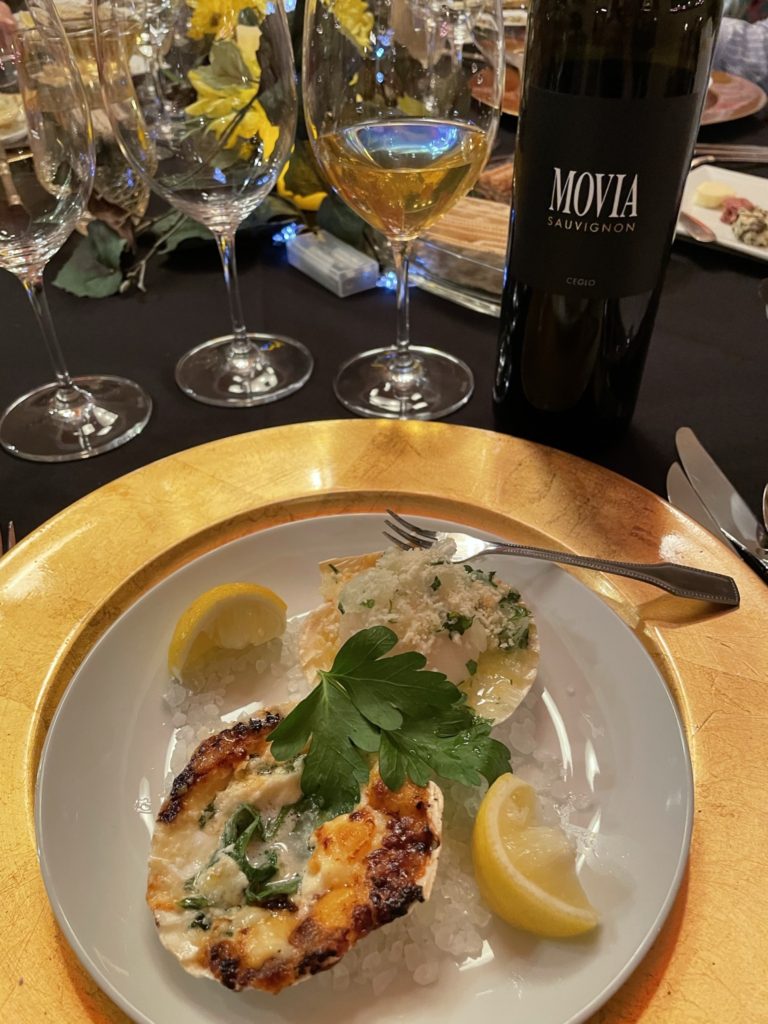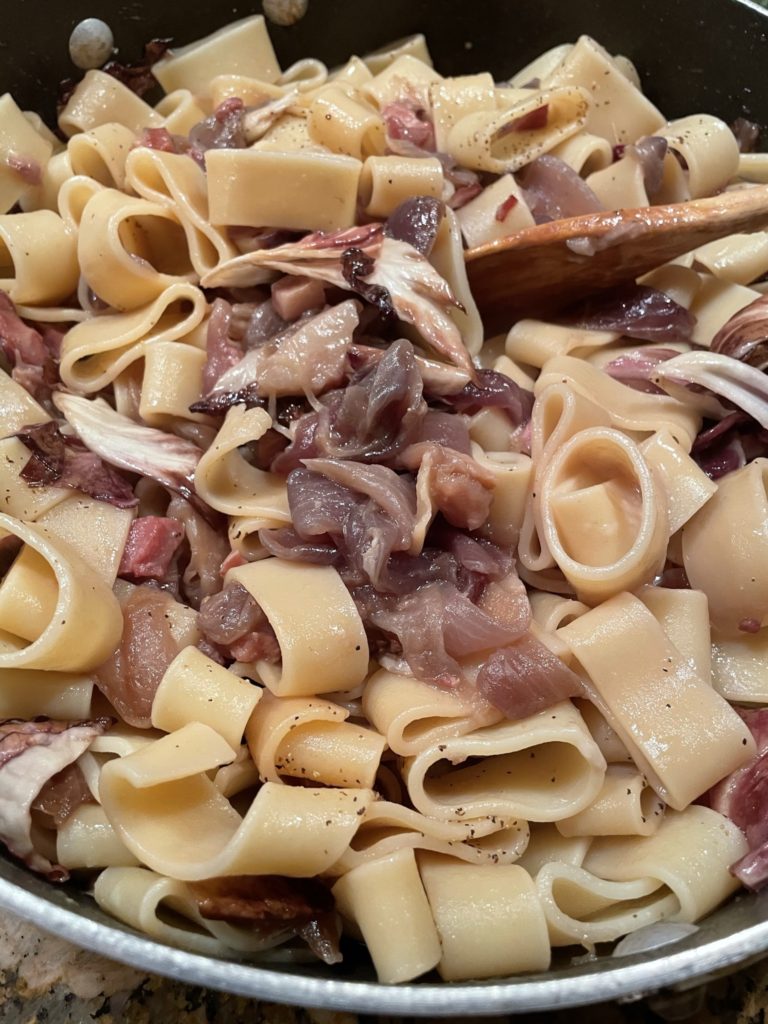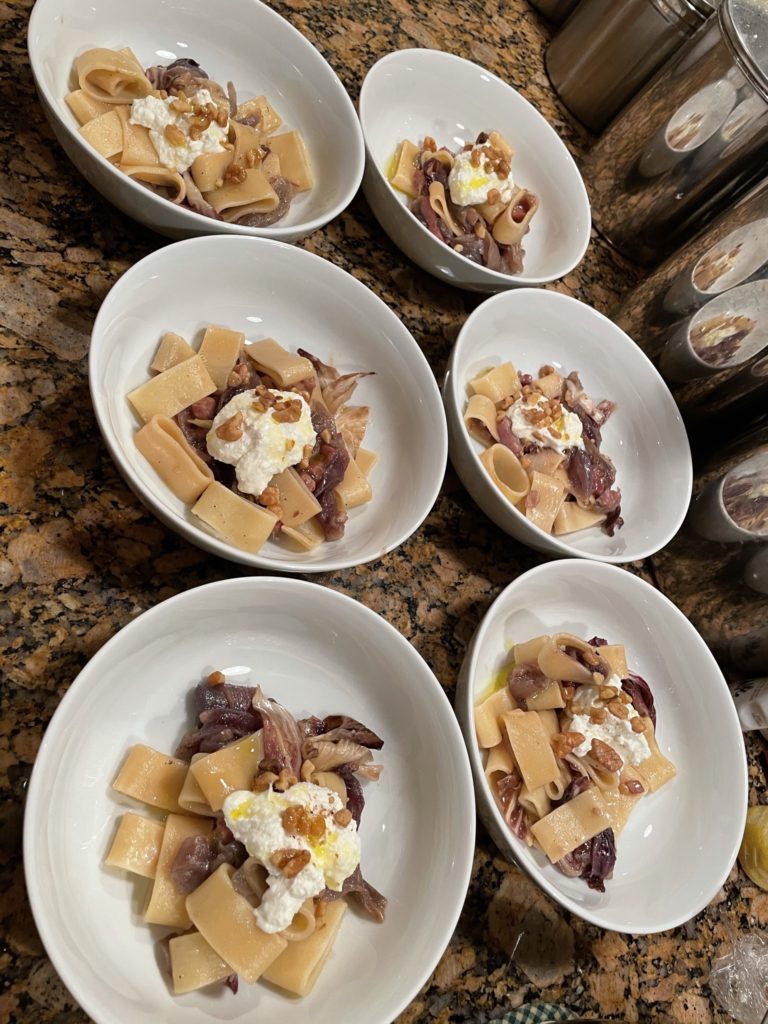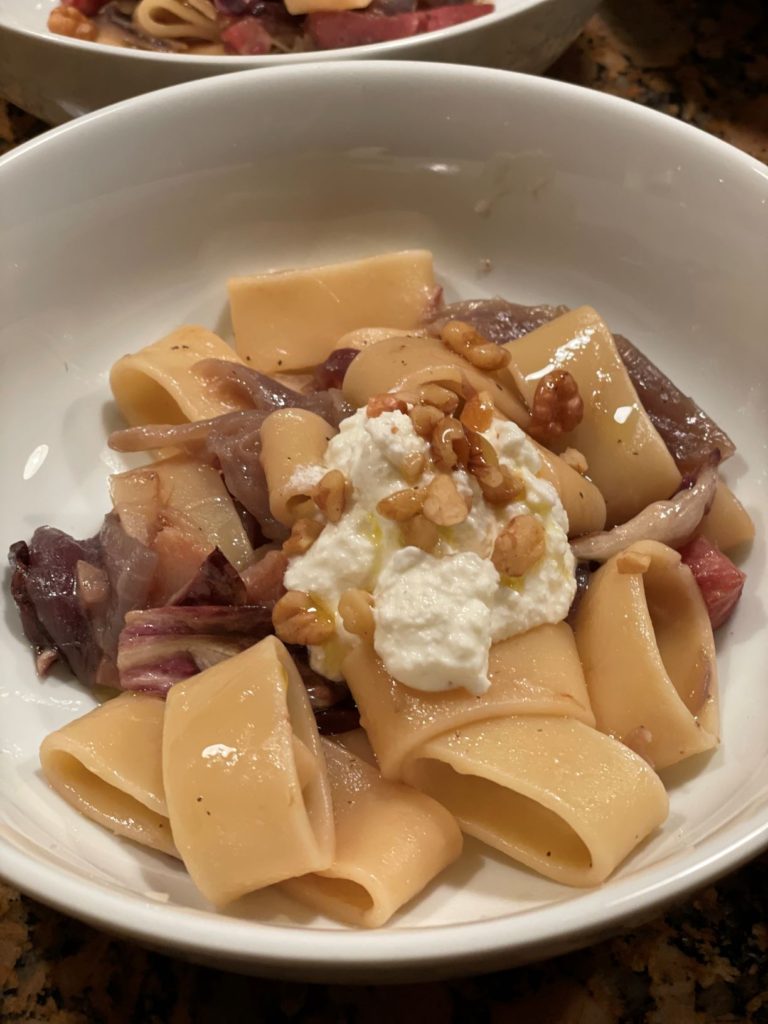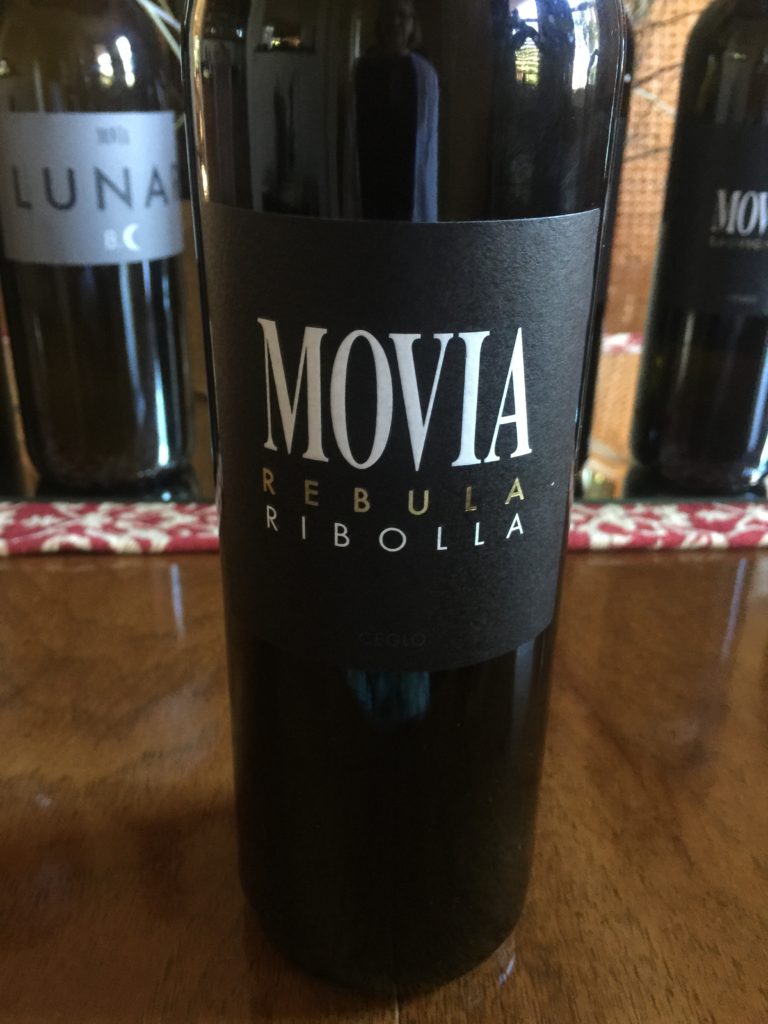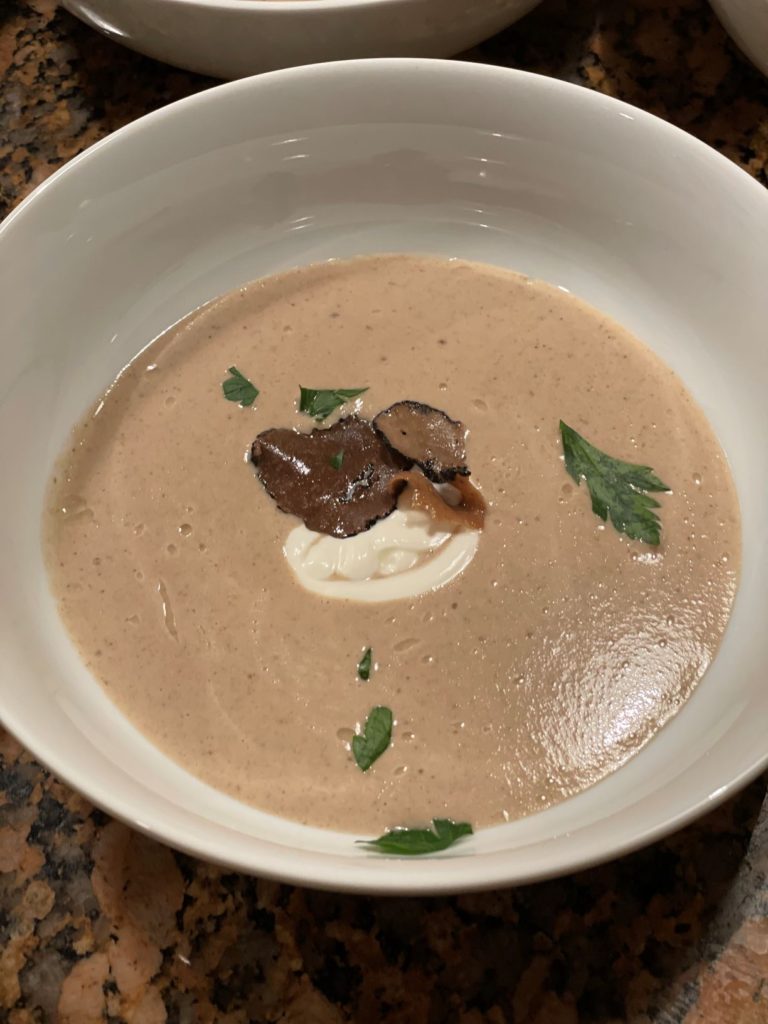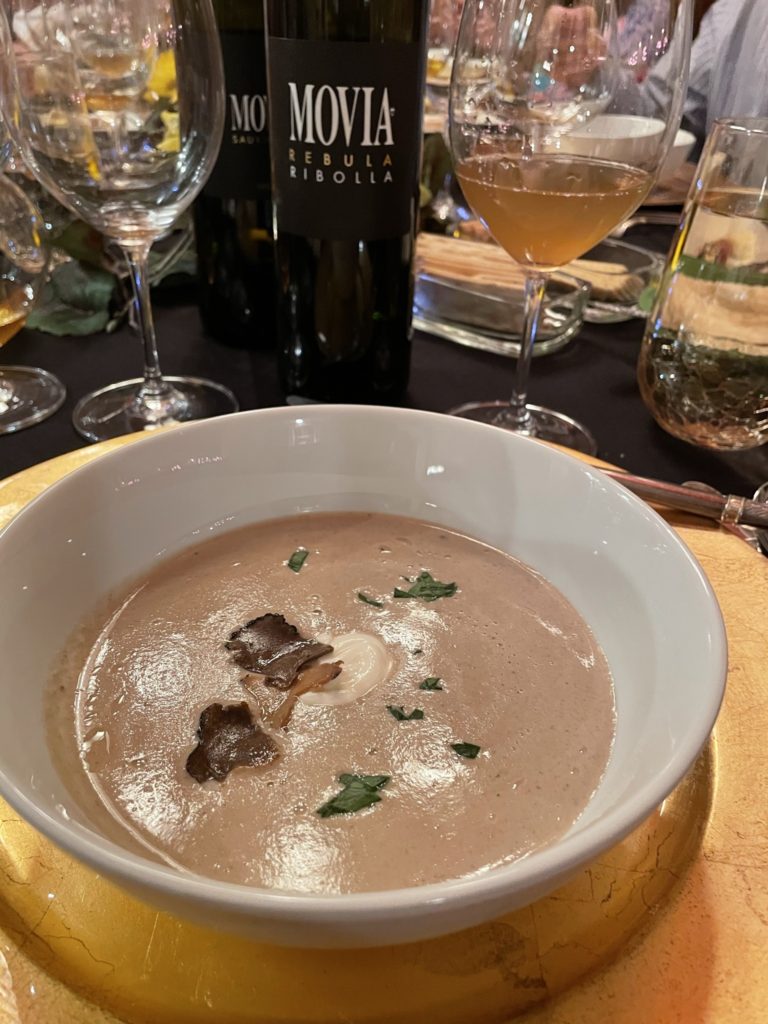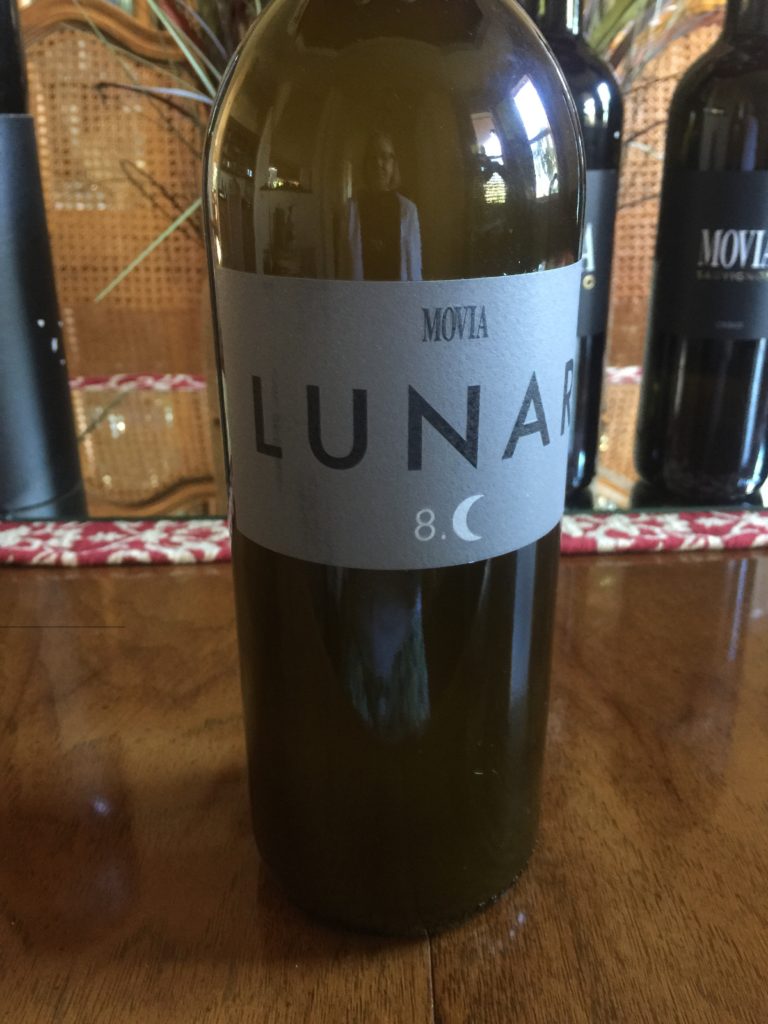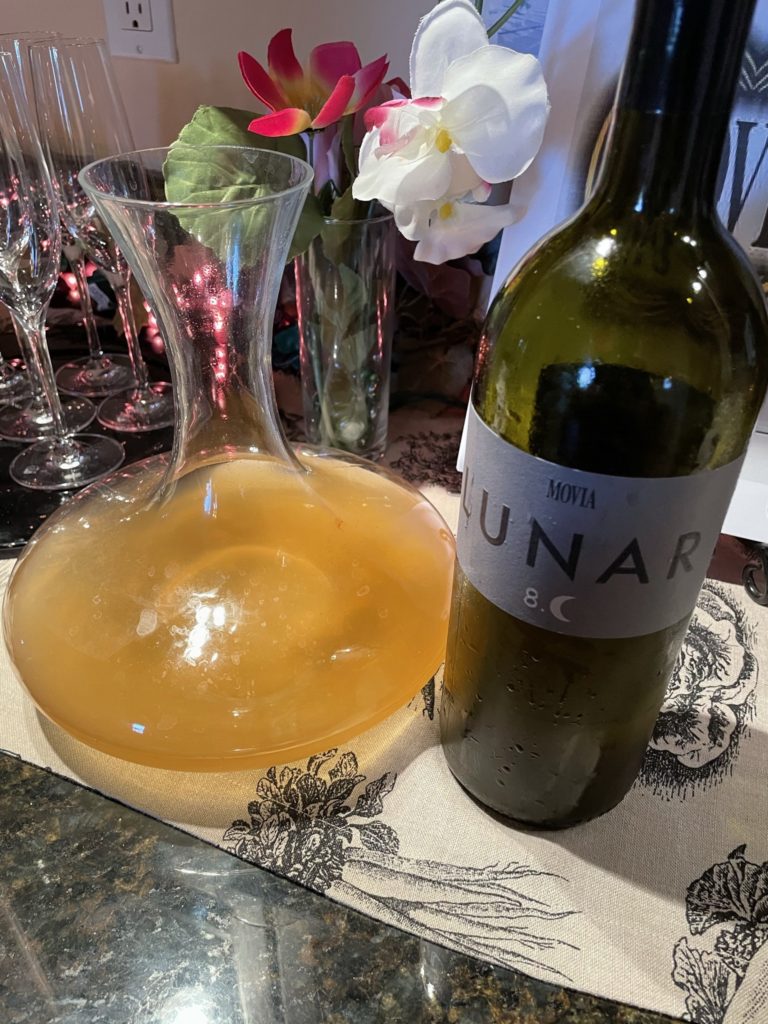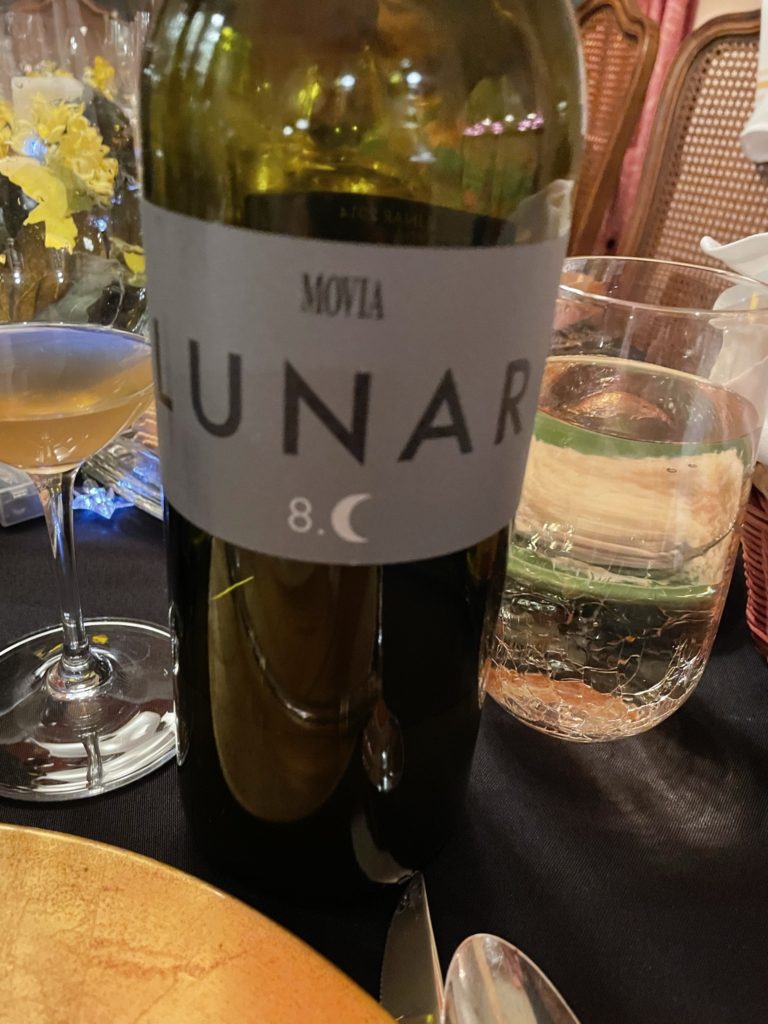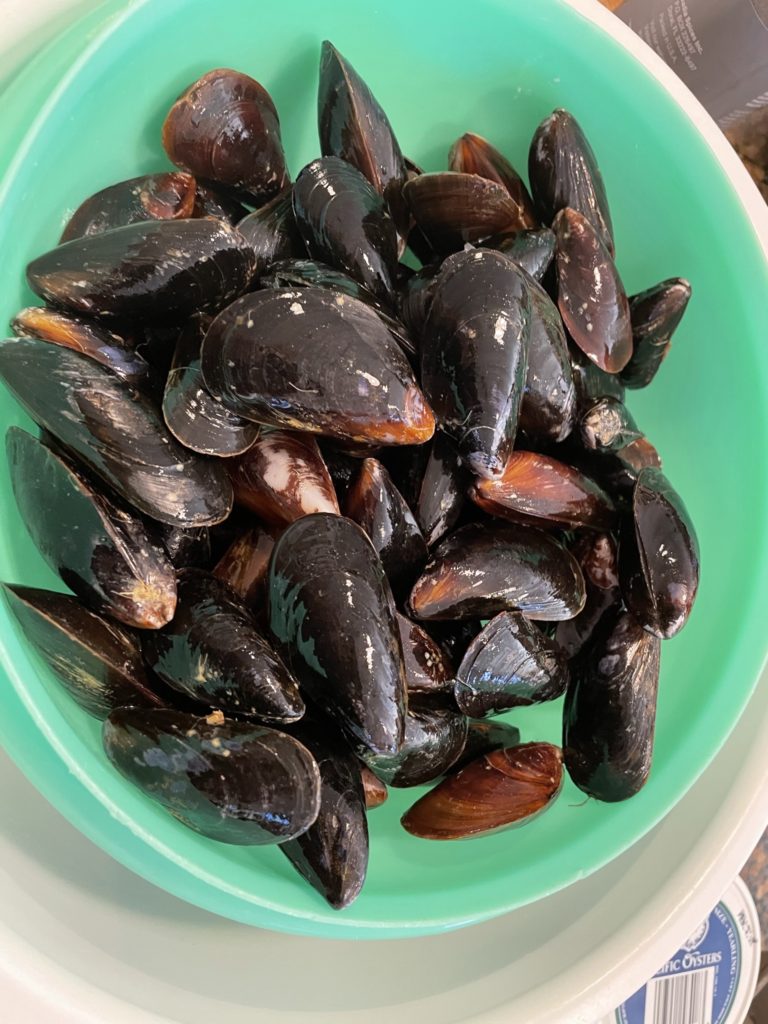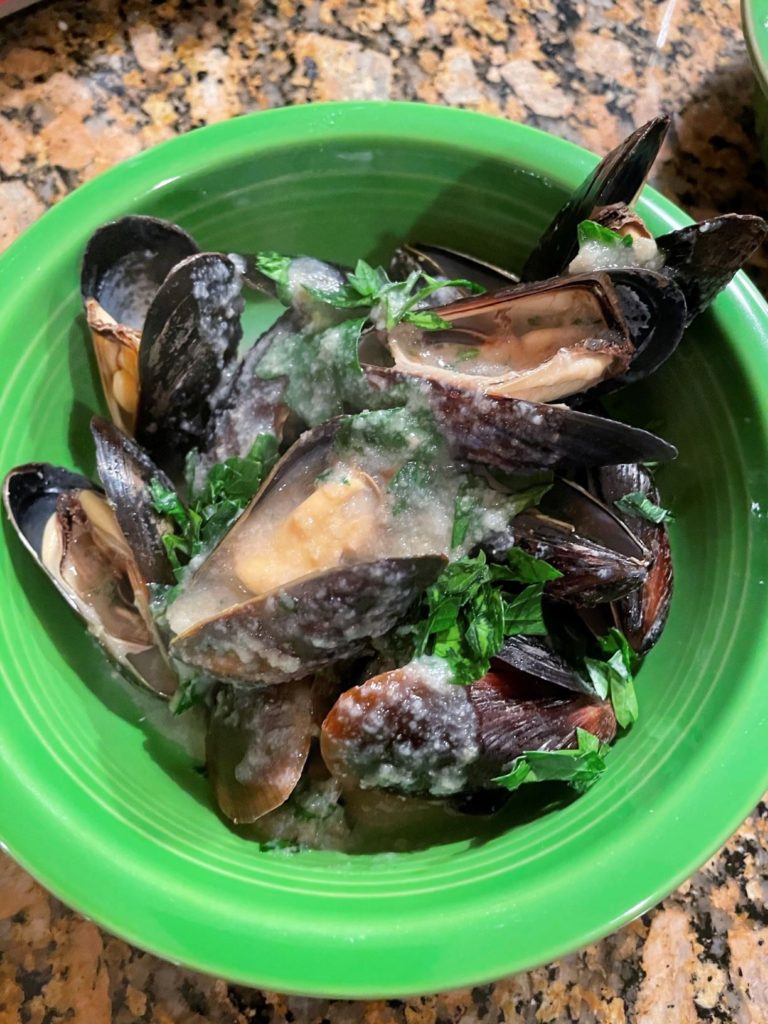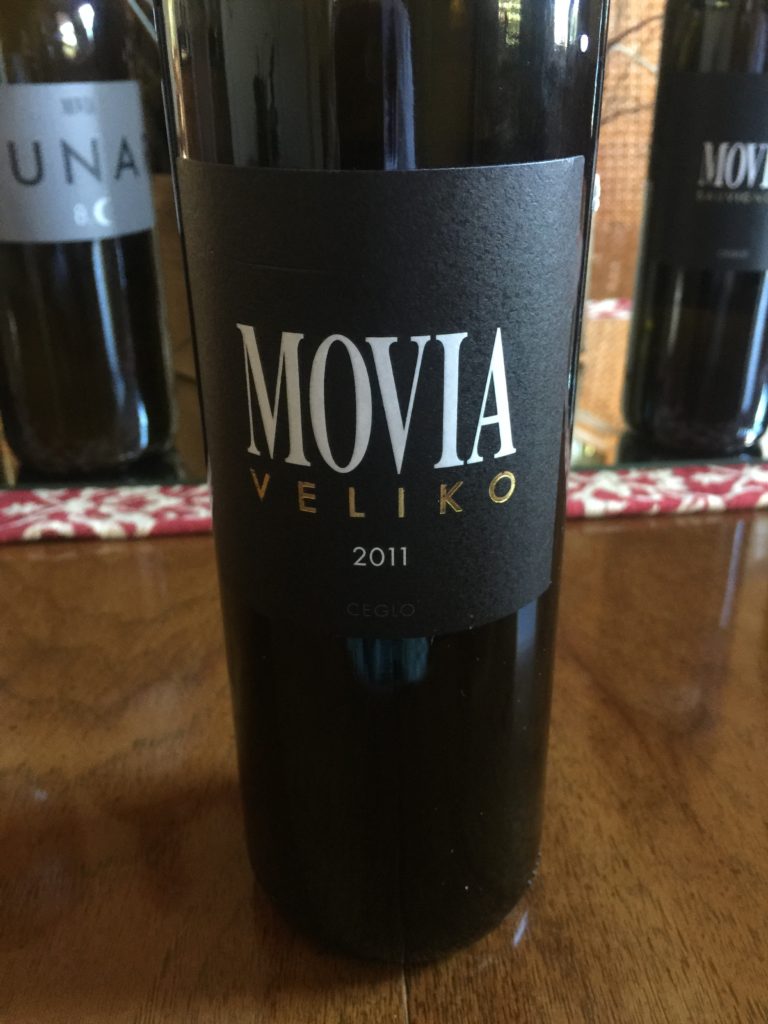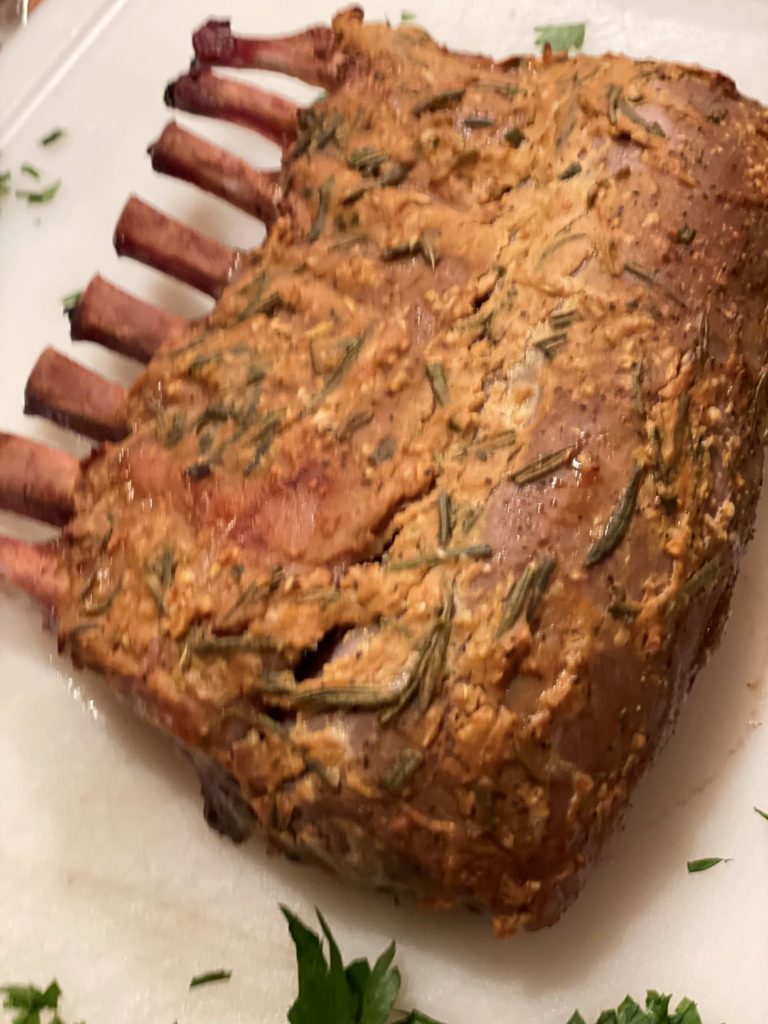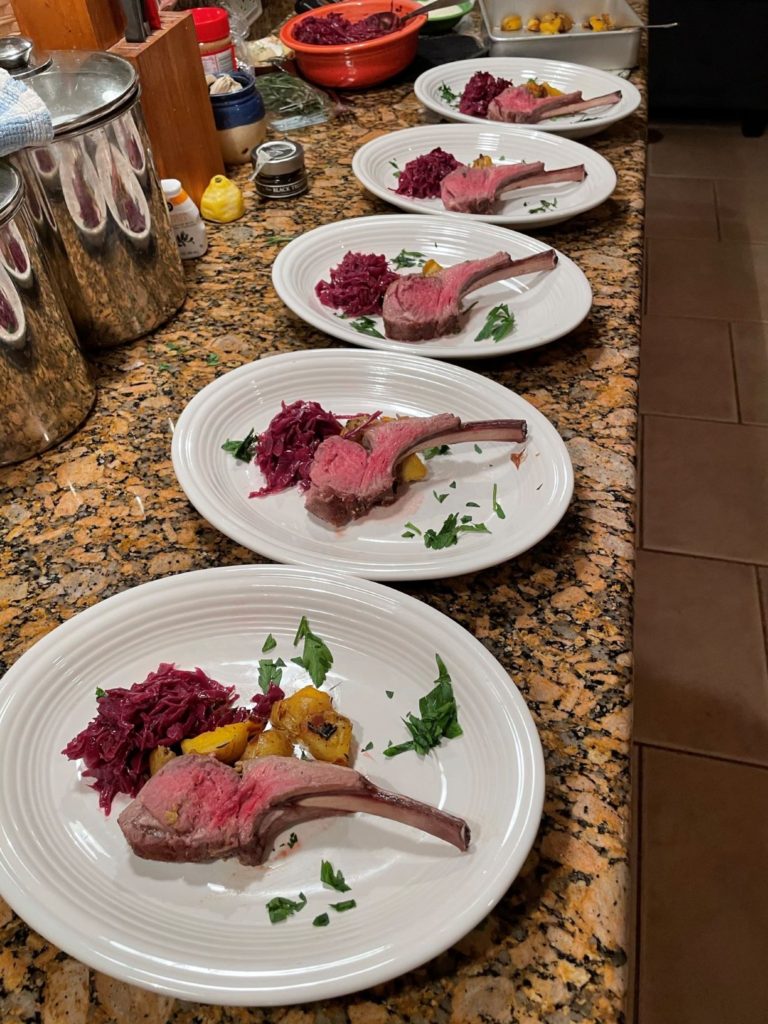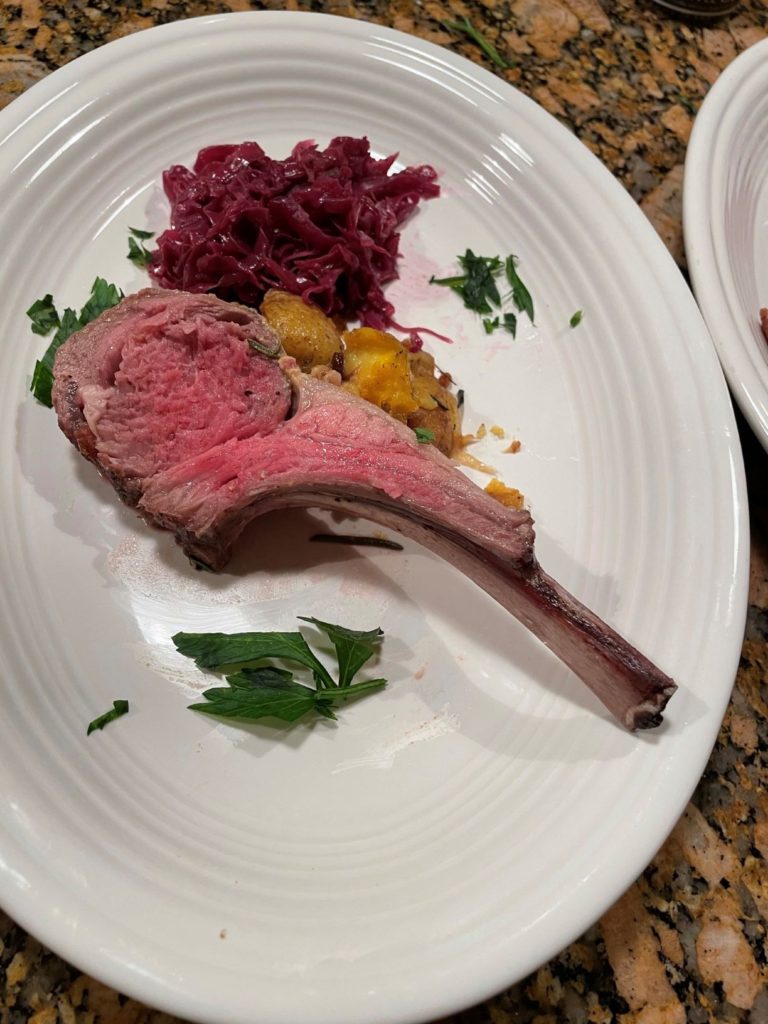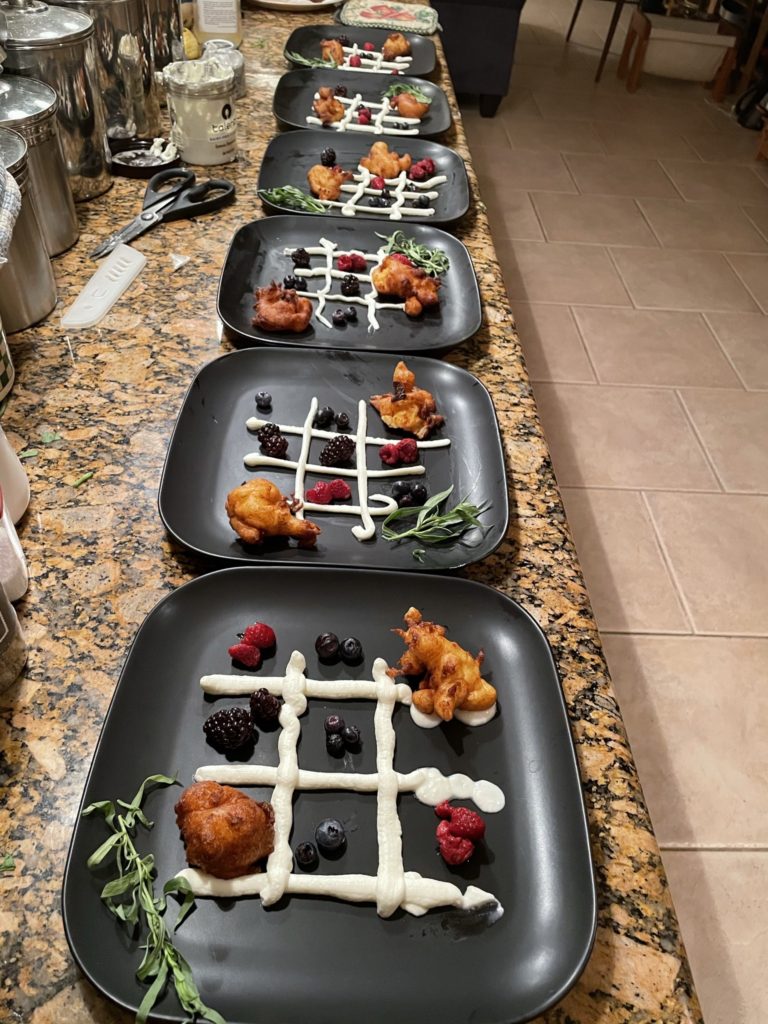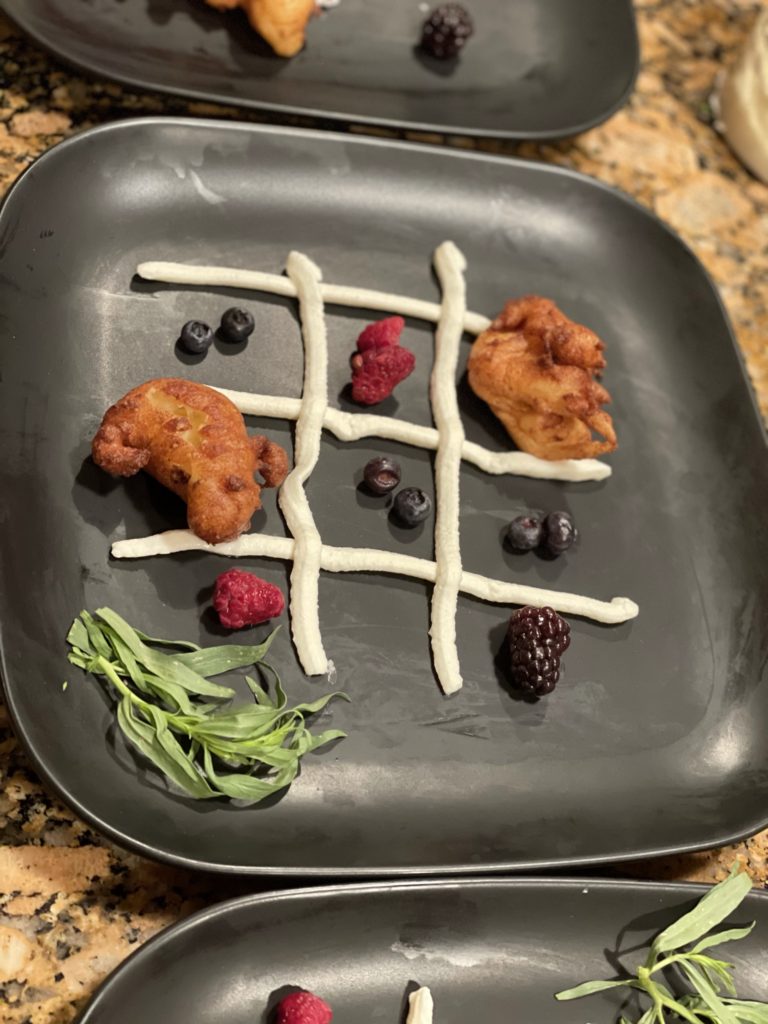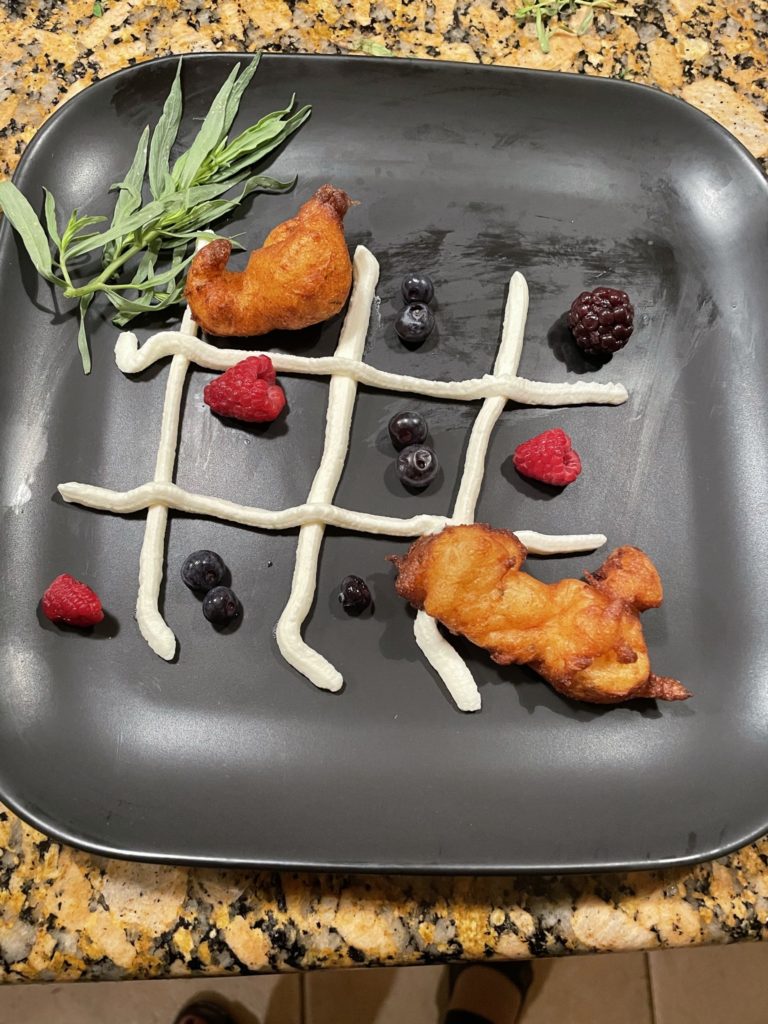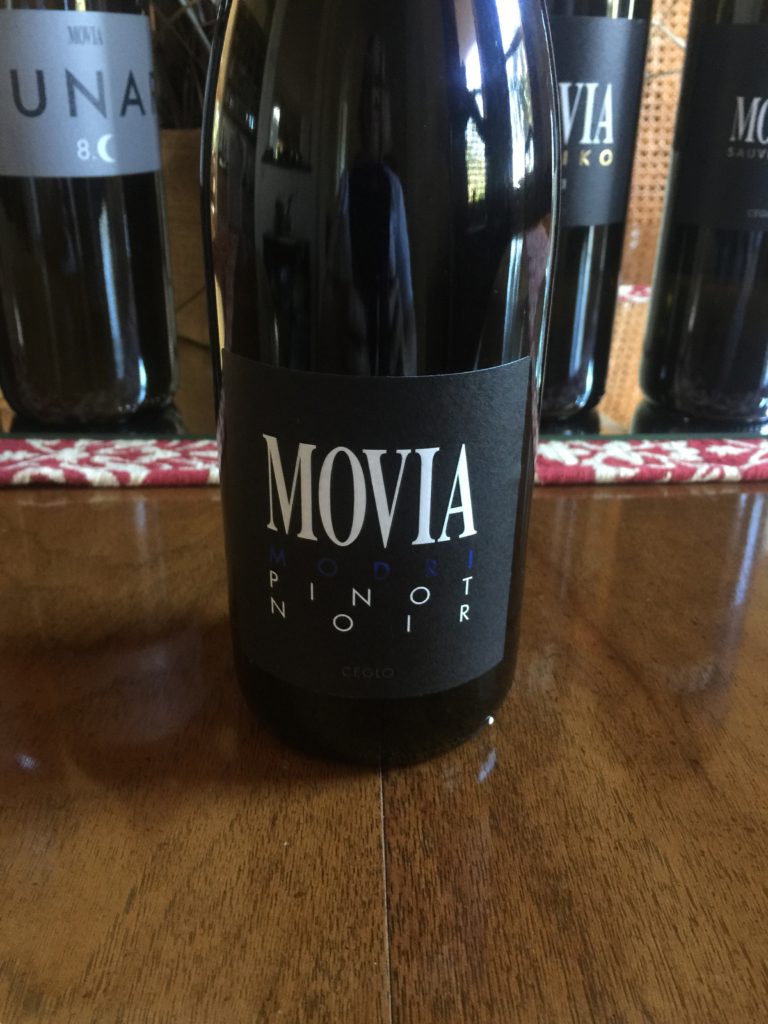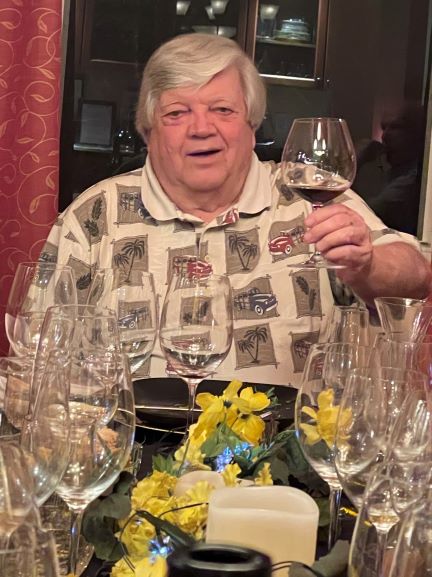Movia……. is a small family wine estate in the village of Ceglo, Slovenia with just 22 hectares (54 acres) of vineyards consisting of vines in two countries –- half of it is in the Goriška Brda region of Slovenia, and the other half is in the DOC Collio region of Italy. One would think that their location alone is enough to create a “unique wine experience”, but it really is not unique for winemaking families in either of these regions to have vineyards in two countries.
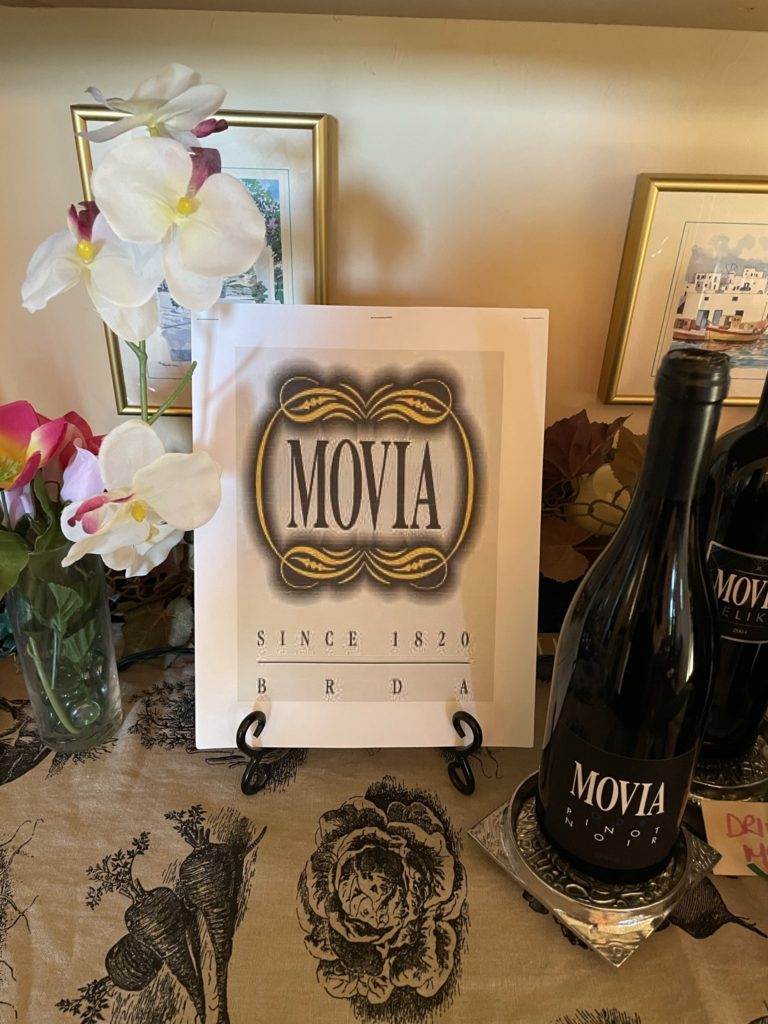
During World War II, the Italians, Germans and Hungarians divvied up Slovenia. Goriška Brda belonged to Italy right up until the end of World War II. The Communist government took over and ruled the area since 1948, and Yugoslavia was created with Slovenia as part of it. The winemakers of future Slovenia were required to give most of their grapes to the government which resulted in their making wine that we winelovers of today would not even think of drinking. But luckily for us, after the Iron Curtain lost control of the region and Yugoslavia disintegrated, in June 1991 Slovenia became an independent republic. The country joined the EU and winemaking families began to grow grapes (grape vines don’t care about your politics!) and make wine in the old family traditions that many of today’s winemakers still honor.
Movia is one of those families. The estate itself dates back to 1700 with the Kristančič family taking control after a wedding in 1820 when the family’s daughter became a Mrs. Kristančič. Ever since then the Kristančič family has been growing grapes using traditional production methods characteristic of the Brda region and making wines that are sought out by wine loving connoisseurs from around the world.
What’s so unique about the Goriška Brda?
There are three main wine regions in Slovenia: Prodravje, Posavje and Primorska with Primorska being subdivided into Vipavska Dolina, Slovenska Istra, Kras and the Goriška Brda – which is located right next door to Friuli and home to Movia. Growing grapes and making wine in the Goriška Brda is like being in “grapevine Eden”. This is the highest per-hectare yielding winegrowing region of all Slovenia, winning many medals both locally and abroad. It’s a land of low-lying gorgeous gently flowing hills in western Slovenia with a Mediterranean climate of moderate summers and sufficient precipitation making it ideal for production of dry wine. Alpine peaks are close enough to provide just enough cool air for higher acidic levels and aromatics in the grapes. With the right winemakers you can expect white wines that are fresh, lively and well balanced with great aging potential. Red wines have great color and develop into an elegant harmony, flavor and bouquet as they age. And Goriška Brda is blessed with a number of “right winemakers” including those at Movia, Kabaj, Marjan Simčič, Edi Simčič and Ščurek. These Slovenians are true “border winemakers” making wine that is organically farmed and expresses its origin of location here on the border of Italy and Austria. Even though they grow grapes in two countries, all of their harvest can be legally bottled as Slovenian; however, it doesn’t work that way in reverse. Slovenian grapes cannot be bottled as Italian. And here’s another “unique” fact: you can find some great producers of orange wines in Slovenia. We’ll give you more info about orange wines later in this article.
The very unique MOVIA
We have been lucky enough to taste wines from several of those border winemakers in the past (Kabaj and Edi Simčič), but today’s focus is MOVIA and the current family member and driving force in charge: the one and only iconic Aleš Kristančič (pronounced alesh chris-stan-zick). Aleš has taken everything given to him from eight generations of his ancestors plus nature, soil and vines and has made this biodynamic organic winery and wines into something that some consider to be unprecedented. So why in the world do Movia and Aleš Kristančič have such a fanatical following? Aleš is a Bordeaux and Burgundy trained winemaker (including Petrus and Domaine de la Romanee-Conti!!) who is historically-minded but yet radical. Many consider him to be extremely controversial. According to Aleš, Hemmingway drank Movia when he drove an ambulance there in World War II. Movia is located just about eight miles from the site of much of the combat Hemmingway later wrote about in A Farewell to Arms. Moving away from more modern winemaking techniques back as long ago as 1988, his low-intervention style had evolved by the early 2000s. Aleš uniquely ages his whites in 600-liter Slovenian oak casks or traditional Slovenian barriques, leaving them on the lees without stirring for more than two years. His reds are made no less uniquely. They age for three to seven years in small Slovenian oak casks, are never racked, and are fined and filtered according to the atmospheric pressure that comes with the arrival of a new moon. Aleš doesn’t follow any particular philosophy. Instead it comes from the wisdom acquired during two centuries of winemaking on the Movia estate — a fine-tuned biodynamics learned by understanding the vines and root management – and combines it with modern marketing concepts. Aleš is reported to be a cult-like celebrity in his fifties, genuine, opinionated, unpredictable, extravagant and a great showman. Sounds like just the kind of winemaker we would love to visit! And when circumstances allow, you can schedule a cellar tour and wine tasting ……….or go to the Movia owned Ljubljana Wine Bar & Shop located in the Ljubljana’s City Hall building. Maybe you will get to enjoy a glass of Movia in one of their own brand of crystal wine glasses – MOVIA CRYSTAL.
Today Movia primarily grows Rebula (indigenous to the region), Pinot Grigio, Sauvignon Blanc, Chardonnay, Cabernet Sauvignon, Merlot and Pinot Noir grapes – all without herbicides, pesticides or fungicides. Rebula and Pinot Grigio are usually bottled separately while Sauvignon Blanc and Chardonnay are most often used in blended wines. We counted a list of 18 vineyards posted on the Movia website making up their 22 hectares. Whites are primarily produced in this region (whites make up almost two-third of wine produced in Slovenia), but reds are also quite good. They make a range of labels, including their entry-level Movia Vila Marija wines and several sparkling and dessert wines, as well as a range of top-level wines from selected vineyards. One-fifth of their production is sold domestically with the remaining product sold to winelovers like us all over the world’s markets. Movia is currently the most well-known winery and one of the very best wineries in Slovenia. According to their importer, annual production is 10,000 cases with a limited amount coming to the US, so if you find one here, GRAB IT! We were lucky enough to finally locate some examples of Movia from several small boutique-type wine shops on the east coast of Florida that were also able to ship to us.
Kristančič’s wines are made in a pink-walled winery in Dubrovo, Slovenia, and the wines are just as quirky as the man himself. Kristančič makes orange wines. He also makes natural wine. That is all pretty unique! The whites are unusually oxidized. For instance the SAUVIGNON BLANC spends two years aging in oak casks instead of being fresh and young. Then there is LUNAR, an orange, honey and nectarine scented Chardonnay and Ribolla Gialla that is aged for nine months in barrels buried 25 feet underground. It’s bottled on the lees and must be decanted to remove the sediment. And if that isn’t unique enough for you, there is PURO! Puro is a crisp minerally sparkling wine made from Chardonnay, Ribolla Gialla and Pinot Noir and bottled undisgorged or still full of the dead yeasts that help produce the bubbles. Guess how it gets disgorged? You do the job! First of all the wine must be kept stored upside down at all times! This moves the sediment toward the neck of the bottle. When you buy a bottle, it comes to you upside down in a special cardboard cylindrical container. If you were lucky enough to buy a bottle, then you or I must place the bottle upside down in ice for at least 20 minutes to freeze the sediment, then submerge the bottle of Puro upside down partly under water and remove the foil wrapper and wire cage. Then keep the cork underwater while removing it until the sediment is released and quickly get the bottle out of water and right side up! Sounds pretty tricky, right? An alternative method suggested by my friend Matthew Horkey at Exotic Wine Travel is to take your bottle outside – while making a “show” for your guests – and still keeping it upside down, remove the foil and cork, and get that bubbly right side up quickly so you have enough to pour for your amazed guests! PURO is produced in Blanc and Rosé (100% Pinot Noir).
Movia also produces red wines – Cabernet Sauvignon, a Burgundian-style Pinot Noir, Merlot and some unique red blends Veliko Rosso including a Bordeaux-style deep-flavored blend of Merlot, Pinot Noir and Cabernet Sauvignon.
Some basics about Slovenian wine
Wine made in Slovenia must be submitted for testing and assigned a quality level according to a system similar to the EU’s Quality Wines Produced in Specified Regions (QWPSR). These are the quality categories for Slovenian wine:
- Table wine (namizno vino)
- Country wine with a certified geographic emblem (deželno vino s priznano geografsko označbo, deželno vino PGO)
- Quality wine with protected geographic origin (kakovostno vino z zaščitenim geografskim poreklom, kakovostno vino ZGP)
- Premium quality wine with protected geographic origin (vrhunsko vino z zaščitenim geografskim poreklom, vrhunsko vino ZGP)
Slovenian wine labels also include the sweetness level of the wines. You will notice that on the Movia wines listed later in my article. They are:
- suho (dry)
- polsuho (medium-dry)
- polsladko (medium-sweet)
- sladko (sweet)
There are four colors of wine produced in Slovenia, yes FOUR! White or “belo”, red or “rdeca”, rose and orange. Note that orange wines in Slovenia are mostly produced in the Primorska wine region.
If you would really like to learn more about Slovenia and her wines, just visit my website http://forkandcorkdivine.com and look for this article SLOVENIA: Can we share some of your LOVE?
Some unique wine styles defined
Orange wine has become much more available and acceptable in the past few years, but just in case it passed you by, here are my “quick sips and tips”. Orange wine, aka amber wine, is actually a white wine made by leaving the juice in contact with the grape skins and seeds resulting in an orange-colored wine. Juice can be left in skin and seed contact from a few days to a year. Winemakers who use this method usually tend to be more artisanal as it is a more labor-intensive and riskier way of making wine.
This non-intervention style of wine tastes different from the traditional winemaking process – it may actually taste sour and nutty. While modern day orange winemaking has only been on the radar for 20+ years, it could possibly date back as far as 8000 years ago in the Republic of Georgia in the Caucasus Mountains where wines were fermented in large subterranean vessels called Qvevri (Kev-ree) that were closed with stones and sealed with beeswax. Winemaking in Qvevri is so unique that in 2013 UNESCO granted the status of intangible cultural heritage (ICH) to the tradition. Even though the orange winemaking style is still not prevalent worldwide, it occurs frequently in Slovenia and Georgia, Friuli-Venezia Giulia in northeastern Italy, some on several other continents and even a few US winemakers.
If you would like to learn more about orange wine, you can read about it in great detail in a 250 page book “Amber Revolution: How the World Learned to Love Orange Wine” by Simon J. Woolf, an award winning English wine and drinks writer. “Amber Revolution” was released by Amazon.com in early October 2018. I’ve got my copy and refer to it quite often!
Natural wine is a very subjective term but generally speaking refers to any kind of wine made with minimal intervention throughout the whole process of growing and winemaking. This includes hand picking from sustainable organic or biodynamic vineyards; no additives, little or no sulfites, and only native yeasts for fermentation. Any impurities in the wine will end up in the bottle. Also sulfite-free wines are much more unstable in the long term which means that if your natural wine wasn’t handled properly, it is far more likely to spoil. The majority of wines made “a la natural” are known for being gamier, funkier, yeastier, sour, and cloudier. Natural wines can be orange, white, rosé or red, and orange wine can be natural if made by the minimal intervention process, which dictates using little to no additives. Many producers of orange wine just happen to be natural wine producers as well. Amazingly enough, for a style of wines that didn’t have any legal definitions or standards, it continues to become more widespread and is creating quite a stir among wine producers of the world.
Some very credible winemakers have been attempting to set standards for natural wines. VinNatur is a wine association founded by Angiolino Maule, an Italian winemaker, in 2006. The association has grown from 65 founding members to 180 producers representing nine countries: Italy, France, Spain, Portugal, Austria, Germany, Czech Republic, Slovakia and Slovenia (according to their website). As recently as July 2016 VinNatur has not only defined “natural” but specified what is allowed and not allowed in the vineyard and in the cellar. To be a part of this association, all wines produced must be officially certified annually by outside labs verifying that no pesticides, herbicides or chemical fertilizers have been used. Some very experienced people in the world of natural wine feel that wines made by members of this association have made tremendous strides in quality over the past few years.
In July 2018 a French politician filed a motion to launch an investigative committee to seek to legally define the term “natural wine” in France. Since an unofficial natural wine movement began in France during the late 1980s, it is quite positive that natural wines have now been formally recognized by the French government. It was announced in March 2020 that a Natural Wines Union was created in collaboration with the French Ministry for Agriculture and the French National Institute for Origins and Quality. The Union has established a list of criteria for its new designation for their “vin méthode nature” wines. They have a three year trial period, and in order to use the designation on a label, the wine has to be produced from hand-picked grapes from certified organic vines and made with indigenous yeast. There can be no cross-flow filtration, flash pasteurization, thermovinification or reverse osmosis. Of course this only applies to natural wine made in France!
You can now find natural wine bars in many cities as well as wine shops specializing in natural wines. In our area of SW Florida, you can visit Natural Wine Naples, (@naturalwinenaples) an all-natural wine store opened in 2016 by owner Peter Rizzo, who says it is the first of its kind in the state of Florida. Please go to Peter’s website to learn more about him and his unique and wonderful wine shop. You will have an enlightening experience! Better yet, visit Peter at his store and see and taste firsthand some excellent selections of natural wines.
Finally! The infamous, unique and excellent wines of MOVIA
The wines described below are those that we have personally been able to source – on the internet of course – in order to have a well-rounded Movia tasting experience. In addition to these wines, Movia also produces a 100% Cabernet Sauvignon, 100% Pinot Grigio/Gris plus Pinot Grigio “Ambra”. Their Vandima Turno wines include “Exto Gredic” made from 100% Green Sauvignon, Cabernet Turno, Merlot Turno, Malvasia Turno and Pinot Grigio. There are several dessert wines: “Esenca”: a blend of Ribolla 60% and Picolit 40% and another extremely unique dessert wine: “Esenca Merlot” made from 100% Merlot. And then there is an entry level selection of wines called Movia Vila Marija.
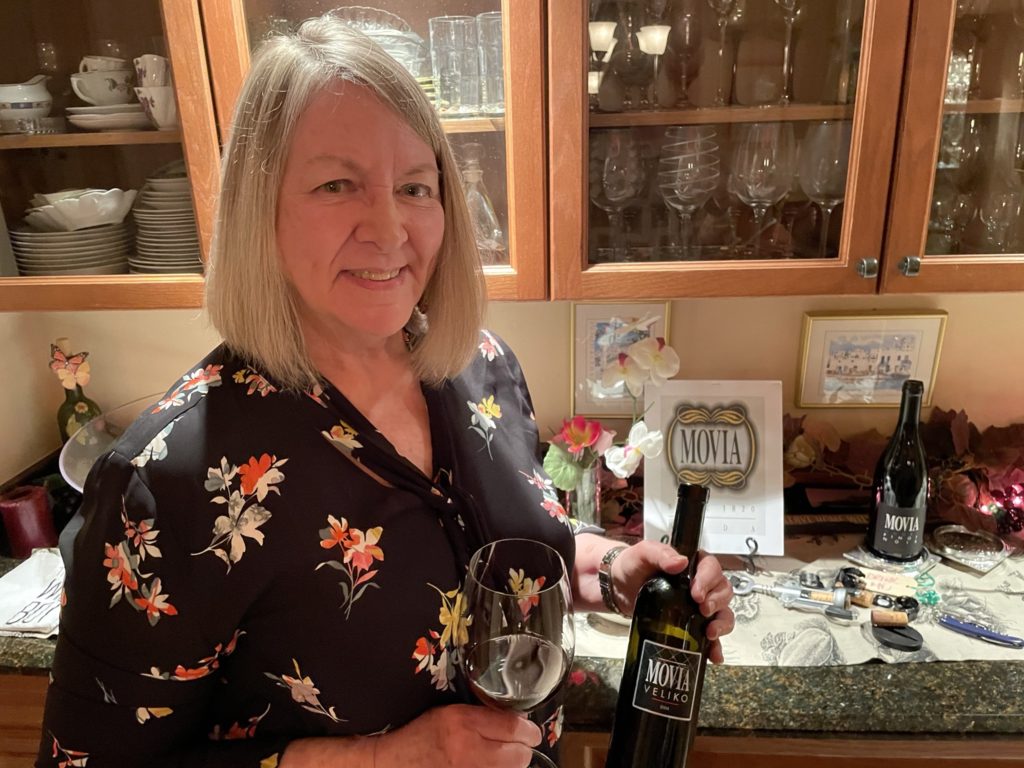
“The Movia Experience” wine dinner
On Saturday January 23, 2021 an adventurous group of six SW Florida winelovers gathered together to taste through our seven Movia wines. Each wine was paired with an appropriate food all prepared by us in our kitchens. It was a unique and amazing adventure, just like the wines, that took us almost five hours to leisurely finish our foods for the table and enjoy the wines. The information about these wines came from the Movia website and several others including Ethica Wines and some of our impressions as we drank them.
Reviewing options and selecting food pairings is no small task which can take me weeks to complete. I usually look through any appropriate cookbooks, google any and all articles I can find on Movia wine dinners, restaurant menus and great chefs in the area, winery websites, and anything and everything else that might help me make my pairings as great as the wine and authentic as possible. In this case, many of my Slovenian recipe ideas for Slovenian olive bread, mushroom soup, mussels, and rack of lamb with roasted potatoes and red cabbage came from “The food and cooking of SLOVENIA” by Janez Bogataj published 2009. Another great source was an article about a Movia/Gordia wine dinner at the Kamin Restaurant Belvedere in Izola, Slovenia. They served an amuse bouche of beetroot, olive and natural butters with Movia Puro, a Japanese-style cold seafood starter with Malvazija, and a pasta with guanciale and radicchio with Movia Rebula. I didn’t have Malvazija but I did have Sauvignon and when I found a recipe for Miso broiled oysters, I knew I had MY pairing. My calamarata pasta with pancetta and radicchio was my version of a Chef Nancy Silverton recipe. It was Chef Alessandro Gavagna whose beautiful dessert recipe I discovered for ricotta bites. Chef Gavagna can be found at greatitalianchefs.com and his restaurant La Subida, “a perfect marriage of Italian and Slovenian cuisine”. I ended up not making Chef Gavagna’s ricotta bites, but I did make ricotta puffs and plated them in true Chef Gavagna style with berries and a piping of elderflower syrup whipped cream.
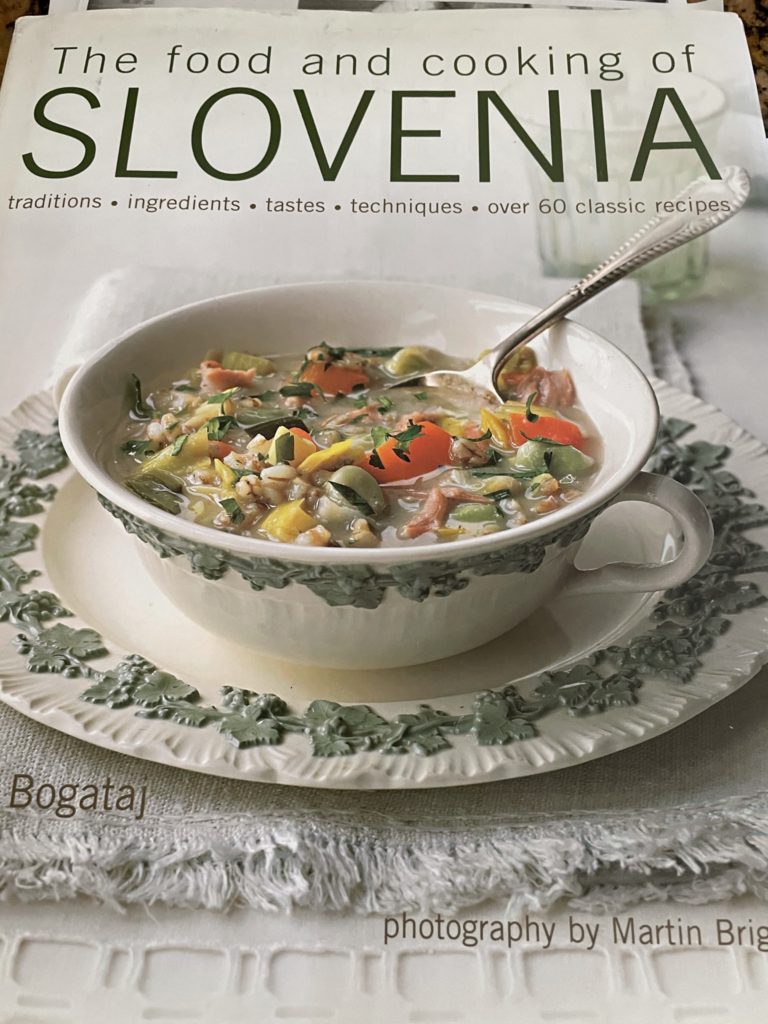
It was an extraordinary evening as was our Movia wine! We hope you enjoy reading about our Movia wine dinner and looking at the pictures of our just as extraordinary food.
First
Movia Puro Rose Spumante, Primorska, Slovenia, 2010
Amuse Bouche:
Natural, Beetroot and Olive Butters with
Homemade Slovenian Olive Bread (Kruh z oljkami)
Mini Charcuterie Boards:
Chicken Liver Mousse with Lavender, Honey and Roasted Pumpkin Seeds
Sopressata, Fennel Pollen Salami and Black Truffle Salami
Pecorino, Manchego and Primo Sale with olives, arugula & red pepper, Olives, Marcona Almonds and Homemade Fig Preserves
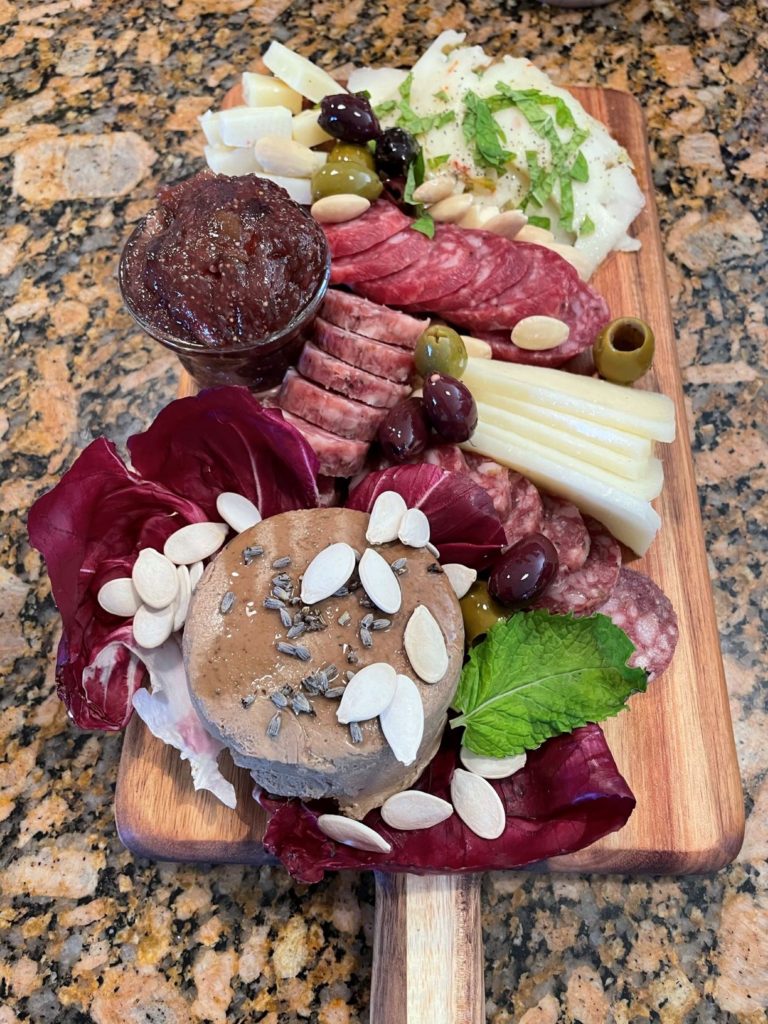
MOVIA PURO ROSÉ Brda Suho Kakovostino Pene e Vino ZGP
REGION Brda – Slovenia VARIETY 100% Pinot Noir
SOIL TYPE Brda Marlstone VINES Mono Guyot
A Puro turned upside-down “can live forever”! According to Movia, the yeast is capable of keeping it alive for years, and there is only as much sulfur as the yeasts produce. For the past 20 years, Kristančič has made vintage-dated, traditional method sparkling wines called Puro—a Chardonnay-based white and a rosé from Pinot Noir—with must added to the bottle (instead of yeast and sugar) and no added sulfur.
Puro is late harvested from a 130+ year old Pinot Noir vineyard, hand-picked, with primary fermentation in large tanks on natural yeasts that they obtained from the same grapes prior to harvest (5%). It is macerated just 1 day giving a sensitive rosé hue, gently pressed at low pressure, and then put into barrique barrels for secondary fermentation on the lees with no racking. No preservatives are used before bottling. After four years in barriques, the wine has completed all of its natural processes and has become naturally stable and ready for its long life! Undisgorged!!
Their most unique quirk is that they are never disgorged, so that the remaining yeasts add a facet of protection to the no-sulfite-added wines. Guess we can’t mention often enough that the bottles are shipped and stored upside-down, requiring disgorgement before serving—by popping the cork face-down in a water-filled ice bucket.
I received that precious bottle of Puro Rosé upside down in its special cardboard cylinder which remained proudly displayed in our dining room until several days before the wine event. It was then relocated to a bed of chiller packs in a large portable cooler as I had no refrigeration built to hold it upside down! Several hours before service it went head first into our large wine bin filled with ice. When the guests arrived, we went on an adventure to the front yard where Chuck somewhat nervously attempted to show off his skills at upside down disgorgement! It was truly entertaining as just as soon as he got the cork off – all the while holding it upside down – it disgorged intense red all over his clothes! But he was a good sport, got that bottle upright quickly and still had plenty of those precious bubbles for us to enjoy.
A glass of Puro Rosé is intense salmon in color with red fruits on the nose, a well matured wine yet still plenty fresh with lots of tiny bubbles for a 10 year old sparkling. It is dry on the palate with notes of hay, dried herbs, flowers, noble wood, balsamic and yeasty notes; it has medium body intense with a bit of tannic grip and definitely not your usual aperitif sparkling. It should pair nicely with warm first courses like vegetable risotto, seafood dishes and fish. It also paired very nicely with our amuse bouche and charcuterie. What a way to get a party started!!!!!!
From our cellar: 2010 Movia Puro Rosé
Sourced from “Mr. D Wine Merchant” Miami, FL
Second
Movia Sauvignon, Primorska, Slovenia 2017
A Shellfish Duet:
One Miso Broiled Oyster and One Capesante Gratinate (Scallop Gratin)
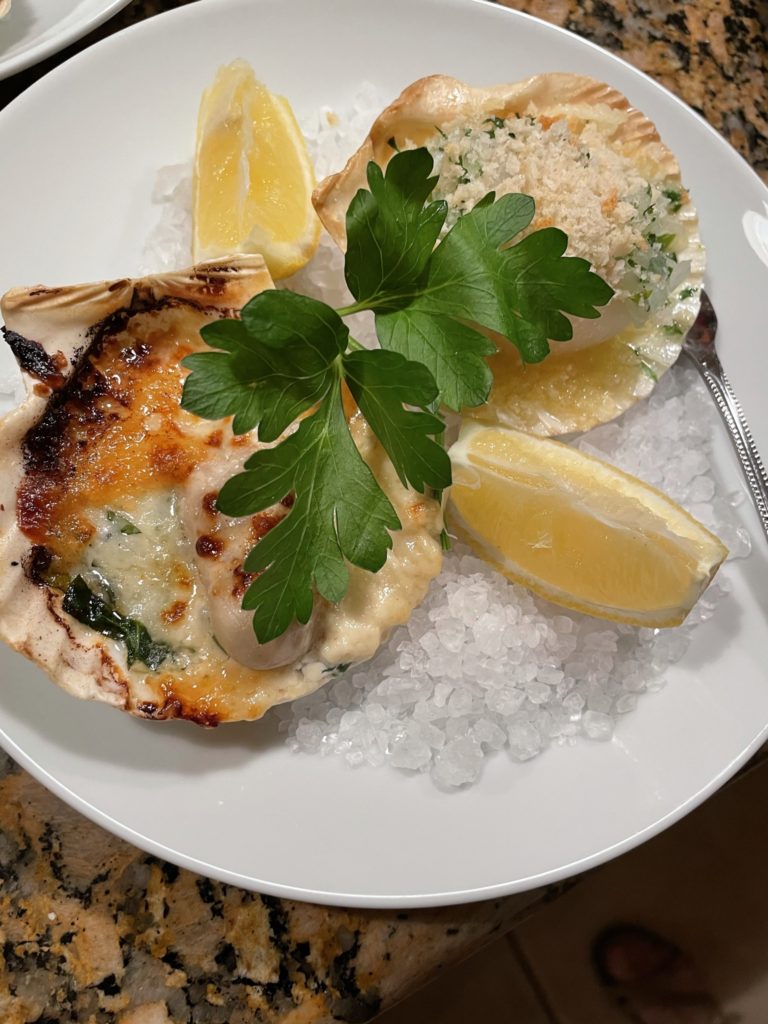
MOVIA SAUVIGNON Brda Suho Kakovostino Pene e Vino ZGP
REGION Brda – Slovenia VARIETY 100% Sauvignon
SOIL TYPE Brda Marlstone VINES Mono Guyot, 66 years old
Movia Sauvignon grapes have been late harvested and hand-picked with a maximum of 2 hours between picking and fermentation. They start out in large fermentation tanks with natural yeast picked out from the same grapes harvested during pre-harvest (5%). They then move to 220 liter French oak barriques for 18 months to mature on the lees without decanting, sulfites or conservatives. They age 4 months in the bottle.
The resulting wine is dry with a touch of sweetness, ripe and vibrant acidity and an oily texture, floral complex and mature. You should also get honey, gentle oak and floral notes. Distinct notes of bell peppers, hay and elderflower are typical of Slovenian Sauvignon. It is great when first released but can be enjoyed for a decade.
Sauvignon is best served chilled between 50-55 degrees F. It pairs well with seafood including shellfish, lobster, crab and shrimp and loves aromatic tomato sauces. Perfect with our oyster and scallop dish. But then we knew it would be!
From our cellar: 2017 Movia Sauvignon
Sourced from “Mr. D Wine Merchant”, Miami, FL
Third
Movia Rebula, Primorska, Slovenia 2016
Calamarata Pasta, Pancetta, Red Onions and Radicchio
topped with Ricotta and Chopped Walnuts
MOVIA REBULA Brda Suho Kakovostino Pene e Vino ZGP
REGION Brda – Slovenia VARIETY 100% Ribolla
SOIL TYPE Brda Marlstone VINES Mono Guyot, 66 years old
Rebula (Ribolla) is claimed by some oenologists to have originated in Slovenia. It’s been cultivated there since at least the 13th century for certain. Rebula vines give a high yield and ripe berries often fall off the grape clusters. Movia Rebula vines average 66 years in age, and they are organically farmed. Grapes are late harvested, handpicked with a 2 hour maximum before fermentation in large tanks with natural yeast picked out from the same grapes harvested during pre-harvesting (5%). Final fermentation is completed in wooden barriques for 18 months and goes through a natural process – on the lees without decanting, no sulfites or conservatives. The wine is aged 4 months in the bottle.
Ribolla (Italian name) comes from “ribollire” meaning to re-boil. The Bora wind in the westernmost region of Slovenia (called the littoral) cooled the wine cellars before the wine could fully ferment, thus stopping fermentation, causing the wine to “re-boil” in the spring.
Movia Ribolla is golden to amber in color due to its longer skin contact. The nose is rich dominated with gooseberries and black currants along with some gentle piney and fine oaky notes. It’s very dry and medium bodied with a bit of tannins and a salty savory character. You can drink Movia Rebula young or over a decade. Serve it chilled to about 50 degrees F. and enjoy it with both saltwater and freshwater fish such as trout, salmon and oysters. I read an article mentioning a famous chef who paired this recipe with Movia Ribolla, so no additional thought was required. If it works for them, I know it will be a great pairing for our guests. And indeed it was. Everyone loved it!
From our cellar: 2016 Movia Rebula
Sourced from “Mr. D Wine Merchant” Miami, FL
Fourth
Movia Lunar Chardonnay, Primorska, Slovenia 2014
Anita’s Mushroom Truffle Bisque
with Sour Cream and Truffle Slices Garnish
MOVIA LUNAR Brda Suho Belo Kakovostino Vino ZGP
REGION Brda – Slovenia VARIETY 50% Chardonnay – 50% Ribolla
SOIL TYPE Brda Marlstone VINES Mono Guyot, 29 years old
LUNAR is a true natural orange wine made with some help from the moon. It’s late harvested and handpicked with a maximum of 2 hours between picking and fermentation, 8 months of macerating with skin contact in new oak barrels with specially adapted lids. Then the wine is gravity racked into bottles under a full moon without added sulphur, filtration or pressing followed by 6 months of aging in the bottle. Could it be like the wine made by ancient man? The result is a medium intense amber color in your glass with a youthful grapelike bouquet, and a spicy woody note with hints of incense and fine herbs. We anxiously awaited to taste it!
We had been told that a bottle of LUNAR should be rested in an upright position for a few days to a week so that sediment settles to the bottom; therefore I placed our bottle upright under refrigeration several days before the dinner. Then when you are ready to drink, carefully open the bottle without disturbing the sediment and oh so carefully pour it into a decanter until you start to see sediment in the neck of the bottle. Then STOP!!! Chuck carefully followed instructions under my “close supervision”. He then decanted several times with the objective being that we had nothing left but a clear precious wine. Since our Lunar never did appear to be clear, we will never know if it was as clear as it should have been. Finally we wanted to enjoy the wine and think about the moon! This wine should be dry, elegant, and youthful but somewhat bitterish due to all of those grape skins disintegrating and remaining in the wine. It definitely had the long aftertaste and we hoped for “extraordinary” but I think our guests were so surprised by the taste that they would call it “unique”. However I think we were fairly successful in removing the sediment if the inches thick sediment in the empty bottle was a clue. Maybe sometime there will be another bottle of Lunar in our life, so we can try to compare. Ales changes the blend every year. Sometimes it’s a single varietal as in 2008, when it was 100% Chardonnay. Other years it’s a blend like the 50% Chardonnay and 50% Rebula in 2013. LUNAR should pair perfectly with white and red meat, cheese and truffle dishes. We served it with an outstanding mushroom truffle bisque from our guest Anita’s kitchen.
From our cellar: 2014 Movia Lunar
Sourced from “Mr. D Wine Merchant”, Miami, FL
Fifth
Movia Veliko Bianca (white), Primorska, Slovenia 2011
Mussels in White Wine Sauce (Pedoči v Omaki Na Belo)
with Lemon, Parsley and Crusty Bread for Dipping
MOVIA Veliko Belo Bianca Brda Suho Belo Kakovostino Vino ZGP
REGION Brda – Slovenia VARIETY 70% Ribolla, 20% Sauvignon, 10% Pinot Grigio
SOIL TYPE Brda Marlstone VINES Mono Guyot, 41 years old
The Veliko Belo is a Movia signature blend of white grape musts still in fermentation, not a composition of finished wines as blends so often are. Three varieties of grapes were blended together: Pinot Gris which makes the wine elegant, Sauvignon which enhances the wine’s aroma and Ribolla which marks the wine’s homestead, Brda terroir and Movia’s wine cellar. This process produces a unique signature wine. These grapes also began with late harvesting, hand-picking and fermentation within 2 hours. As in other Movia wines, only natural yeast picked out from the same grapes harvested during pre-harvesting (5%) is used. After three and a half years of maturing on the lees without decanting in French barriques and 12 months in the bottle, it is ready for the world to enjoy! Sometimes a small percentage of aged wines are added to the Veliko Belo making it even more unique.
The color was a quite intense old gold with a complex nose fresh with honey, wild flowers, blackcurrant, orange peel, caramel and butterscotch notes on the palate……or at least we imagined we could taste them! It was very dry with acidity and a touch of tannins. Veliko Belo is meant to pair well with a wide variety of foods and is made to last for a decade or two. Our bottle was almost a decade old and it paired extremely well with those mussels in white wine sauce.
From our cellar: 2011 Movia Veliko Bianco Belo
Sourced from “Mr. D Wine Merchant”, Miami, FL
Sixth
Movia Veliko Rosso (red), Primorska, Slovenia 2004
Roast Rack of Lamb (Pečeno Jagnje)
Sauteed Potatoes (Prazen Krompir)
Braised Red Cabbage
MOVIA Veliko Rdeče Rosso Brda Suho Rde Kakovostino Vino ZGP
REGION Brda – Slovenia VARIETY 70% Merlot, 20% Pinot Noir, 10% Cabernet Sauvignon
SOIL TYPE Brda Marlstone VINES Mono Guyot, 35 years old
By this time, we were ready for some red and this one was a great example! Three varieties that make up the Rdeče are also harvested as late as possible, and hand-picked with short vine-to-fermentation times of 2 hours maximum. All three varieties macerate together giving them new style, flavors and aromas. Merlot is the wine’s backbone giving it character, punch, resilience and ageing potential. The Cabernet gives its some fruity aroma of blackcurrants. Last but not least Movia says that the Pinot Noir grapes bring “the element of love”. Primary fermentation is in large tanks on natural yeasts obtained from the same pre-harvested grapes (5%). The wine is macerated 3 to 4 weeks until the end of fermentation when the pomace cap settles and naturally clears the wine. Secondary fermentation is completed in barrique barrels on the lees, with no racking, sulfites or any other preservatives allowing the wine to complete its natural processes and last a human lifetime. Maturation lasts 6 years in 220 liter French oak barrels followed by 6 months in the bottle.
The color of our Rdeče was garnet with medium depth. The nose was mature but a bit subtle and fine with spices, blackcurrants, hints of truffles, dark chocolate and fine oak. It is meant to be reminiscent of Bordeaux grapes and style. The aroma was unique and long lasting – all quintessential Movia! It is meant to pair well with red and grilled meat, lamb, tuna and aged cheeses…………….and our rack of lamb with sautéed potatoes and braised red cabbage, all typical Slovenian main fare.
From our cellar: 2004 Movia Veliko Rosso (Rdeče)
Sourced from “Wine Watch, Inc.” Ft. Lauderdale, FL
Seventh
Movia Pinot Nero/Modri Pinot, Primorska, Slovenia 2013
Fried Ricotta Puffs
with Tarragon, Elderflower Whipped Cream and Berries
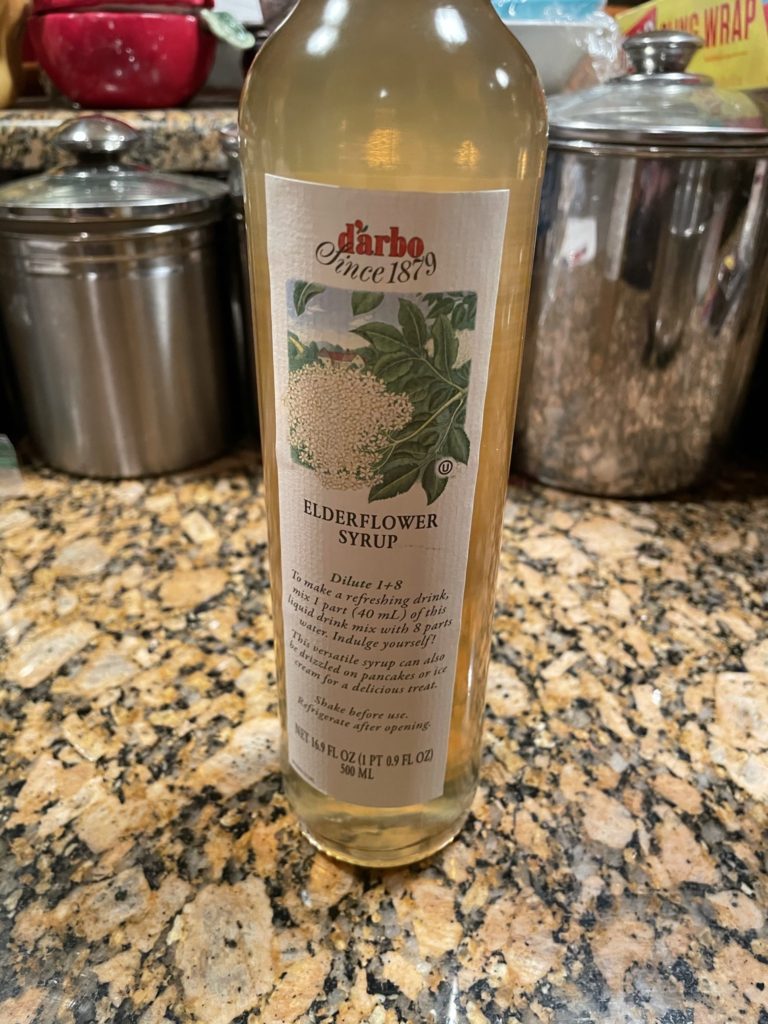
MOVIA Modri Pinot Noir Brda Suho Rde e Kakovostino Vino ZGP
REGION Brda – Slovenia VARIETY 100% Pinot Noir
SOIL TYPE Brda Marlstone VINES Mono Guyot, 30 years old
Last on our list but not at all least was a Pinot Noir. Movia has been producing Pinot Noir since 1973. According to notes by Movia, “Pinot Noir is like a virus. Once you are infected, there’s practically no cure.” But it is also one of the most difficult grapes to grow. It has a mind all of its own and is truly a unique grape. Pinot Noir is also the “acid test” of a winemaker. If it is great, you get many accolades. Otherwise you are just another “ho hum” winemaker. Obviously Pinot Noir is one of Movia’s flagship wines. Would we expect anything different? As is customary, the grapes are late harvested, hand-picked with a maximum of 2 hours between picking and fermentation.
Fermentation is begun in large tanks with natural yeast picked out from the same grapes harvested during pre-harvesting (5%). Maceration takes place from 3 to 4 weeks till completion of fermentation and the cap of grape skins sinks to the bottom of the tank and clears the wine naturally. The wine is then ready for fermentation in 220 liter French oak barriques for up to 4 years to mature on the lees without decanting. Bottles are placed on their side for 6 months before release. The color was deep garnet with an unmistakable Pinot Noir nose of leather, earthy notes and forest fruits followed by a dry palate with firm silky tannins and enough acidity to give it character and longevity. It was just right with the blueberries, blackberries, raspberries and elderflower syrup on our dessert plate. How unique is that? And just in case you didn’t notice, tarragon is widely used in this part of the world. I also added chopped tarragon to the ricotta puffs batter. It was a great flavor addition.
From our cellar: 2013 Movia Pinot Nero/Modri Pinot
Sourced from “Mr. D Wine Merchant”, Miami, FL
Mission accomplished! We drank seven unique and excellent wines of MOVIA and enjoyed them with seven courses of food pairings.
No small task! Our wine dinner lasted about five hours in order to accomplish this feat, but it was so worth it. None of us may have the opportunity to taste Movia again and for sure not all seven different wines. We expected “unique” and we got it! After all, MOVIA wines are made like nature intended. They are natural, biodynamic and many are orange. LUNAR comes full of sediment and PURO sparkling comes to you undisgorged! Let’s face it – these wines aren’t for the casual wine drinker! They are for those of us willing to try every wine style, every grape, and every wine region unfamiliar to us from around the world. We are probably considered “wine geeks” by many. That’s OK with me. I enjoyed every one of these wines and will never forget our “MOVIA experience”. And I am quite sure our guests would say the same.
Many thanks go to Matthew Horkey at Exotic Wine Travel for his advice on how to store and open Movia wines, his suggested order for service and all of his encouragement and excitement for Movia wines to travel from Slovenia to us here in Southwest Florida. We’ll drink a toast “together” with Matthew at the huge social distance of half way around the world!
Credit also goes to Simon J. Woolf for his book “AMBER REVOLUTION: How the world learned to love orange wine” published in 2018. I’ve read that book from cover to cover, and refer to it quite often when researching and learning about new wines. I highly recommend it if you have an interest in amber/orange wines.
I am also “over the moon – LUNAR” happy to have found these wines at two boutique wine stores on the east coast of Florida –“Mr. D Wine Merchant” in Miami and “Wine Watch” in Fort Lauderdale. Those are our favorite type of wine stores – those who seem to have a great appreciation for more “unique” wines from the far corners of the world. Without wine stores like these, we would never be able to experience such unique wines. A winelover’s life is never boring! Adventure is out there………..you just may have to search for it!
And I absolutely must mention the fact that without our circle of adventurous wineloving foodie friends, my wine dinners – which are considered wild and crazy by many! – could never come to reality. They not only tolerate my ideas but they get excited about them, assist with food preparation, plating, service of food, clearing of courses, and cleanup! And then they ask “What’s our next adventure”? How lucky am I to have friends like that! Now I have saved the best for last – my husband, Chuck, also the other half of forkandcorkdivine.com not only tolerates my obsession of wine and wine dinner presentation but he also assists me in every way possible. Maybe he also has an ulterior motive because he knows that once I pick a new wine region or event, I will be kept busy for months! So what’s our next adventure you may ask? I am actually shocked myself to say that I have not yet selected one. COVID and world-wide pandemics definitely change your life. But I guarantee you there will be one coming before too long. So please enjoy drinking wines that you like but don’t forget to try something new!!!! See you for the next adventure.
2.6.2021
Forkandcorkdivine.com

